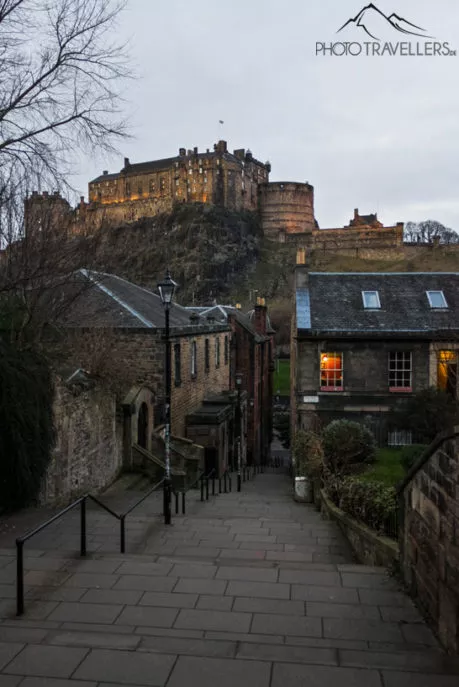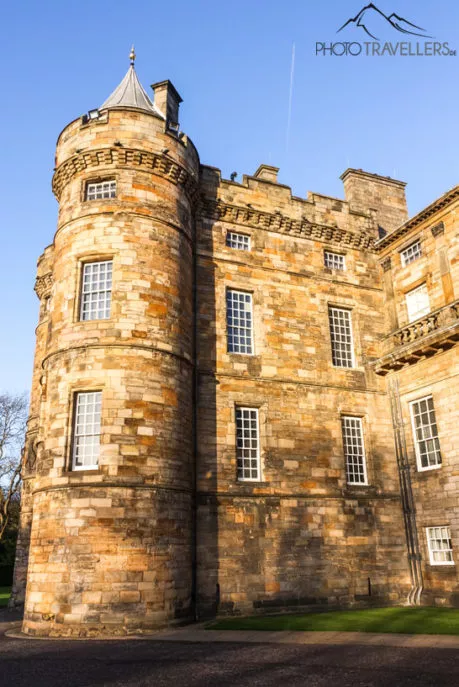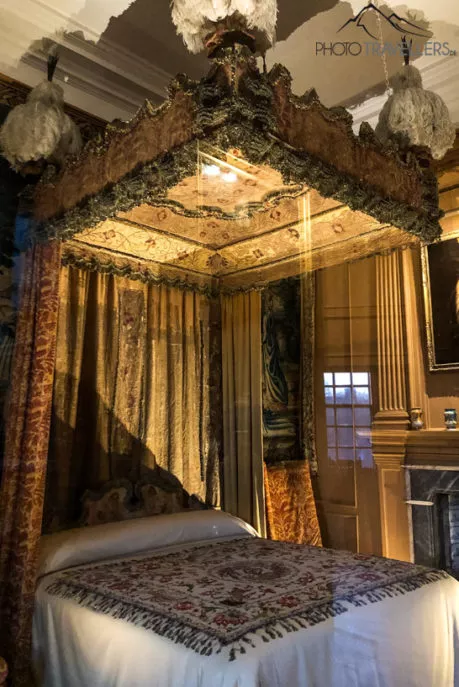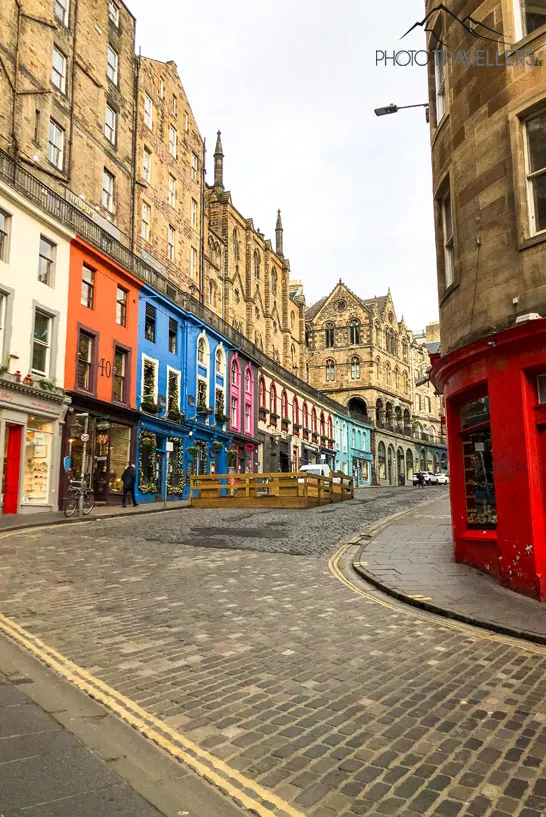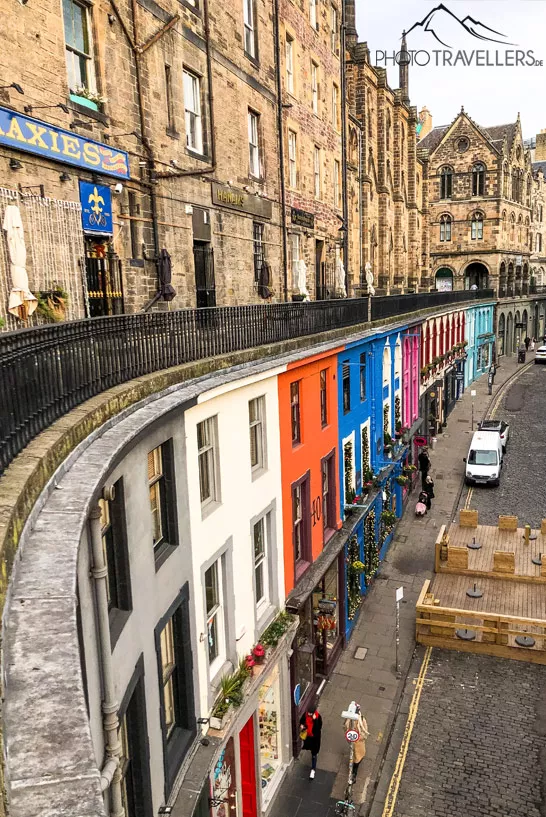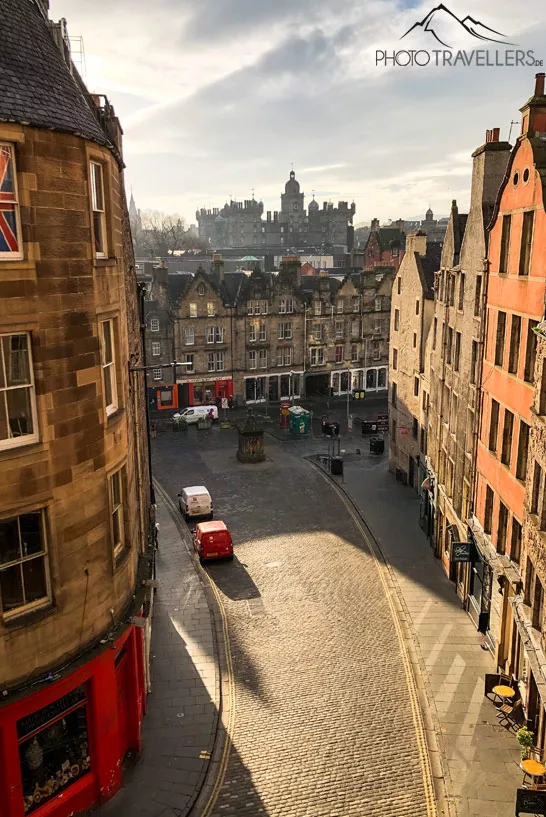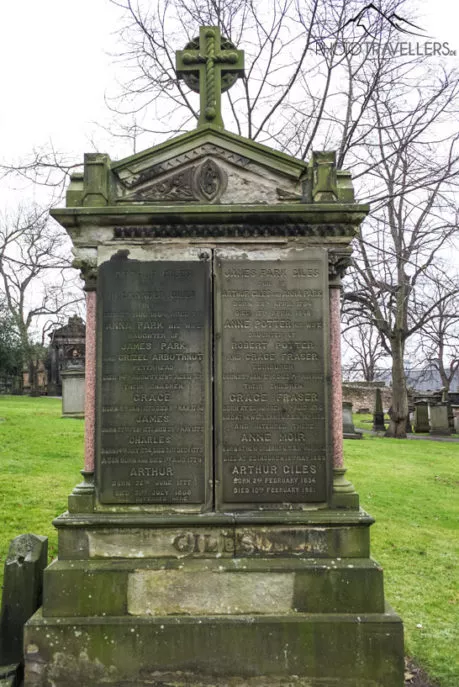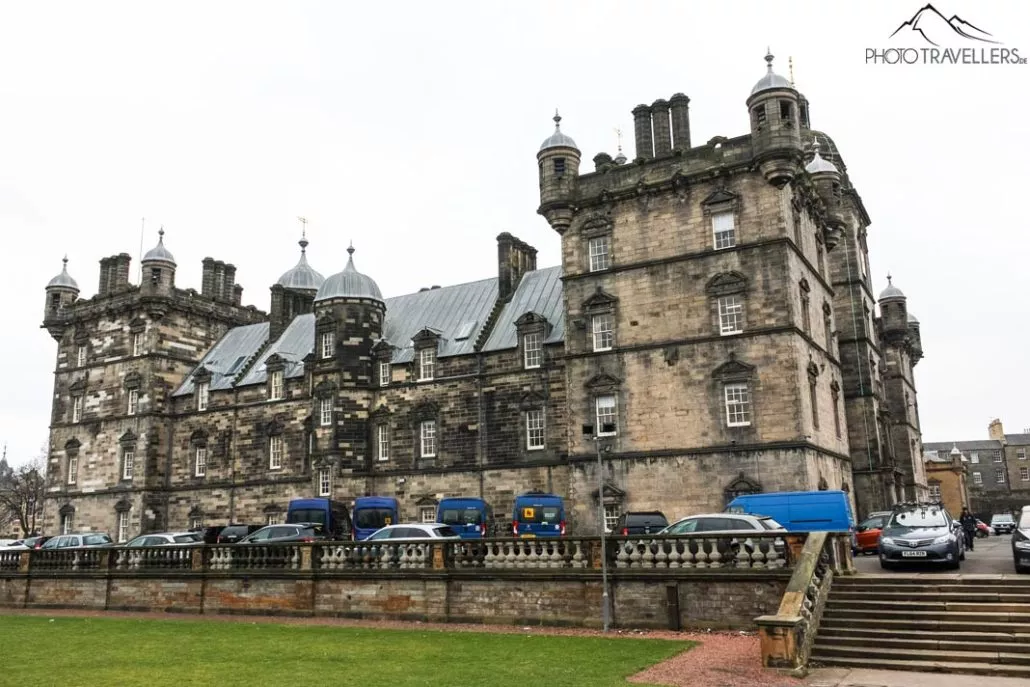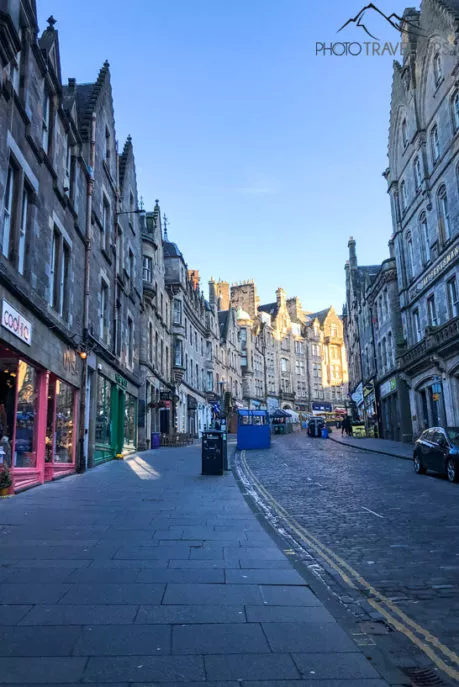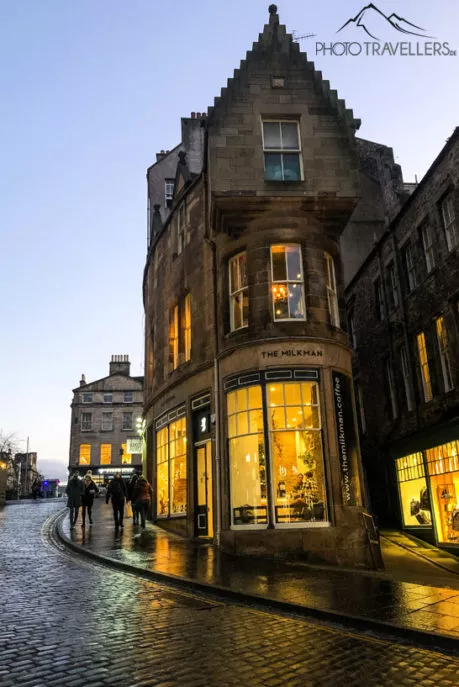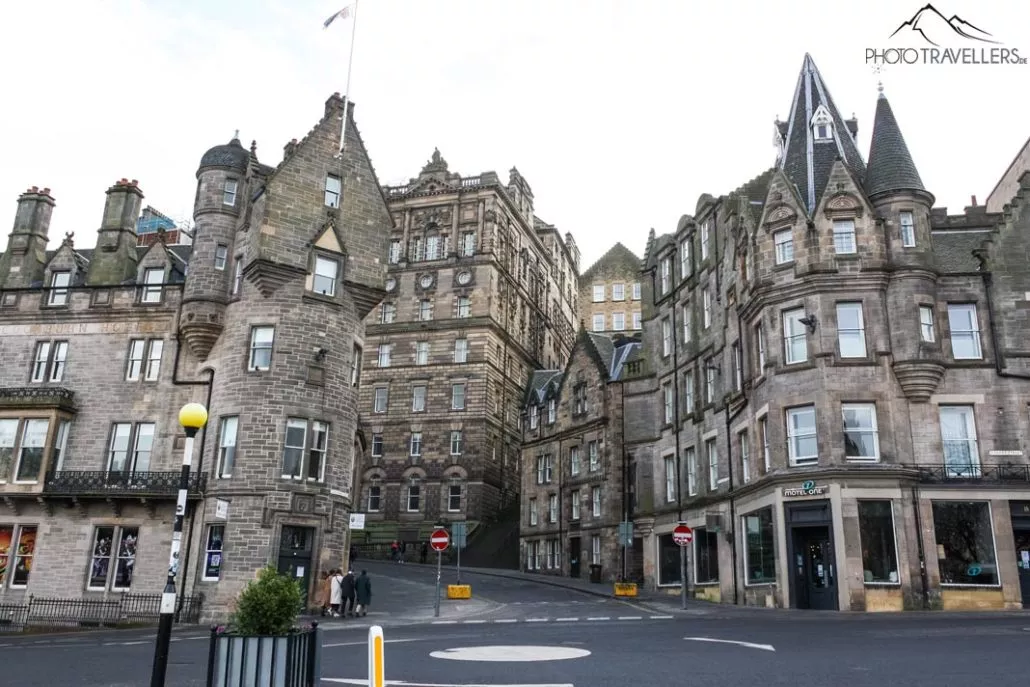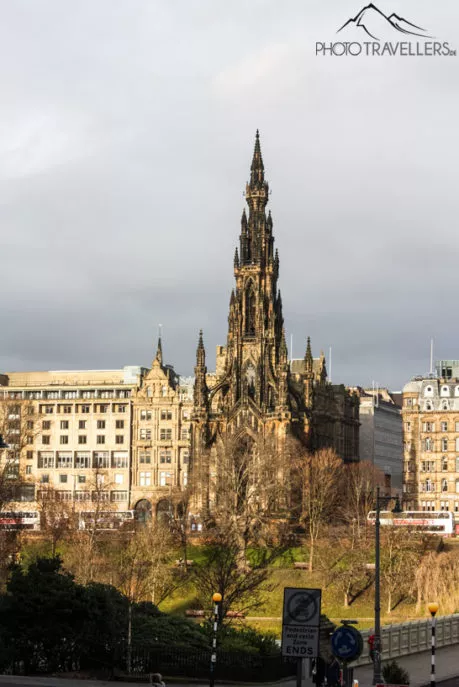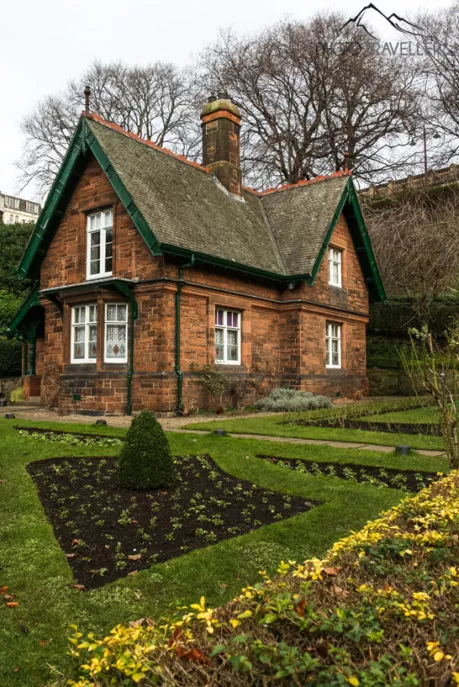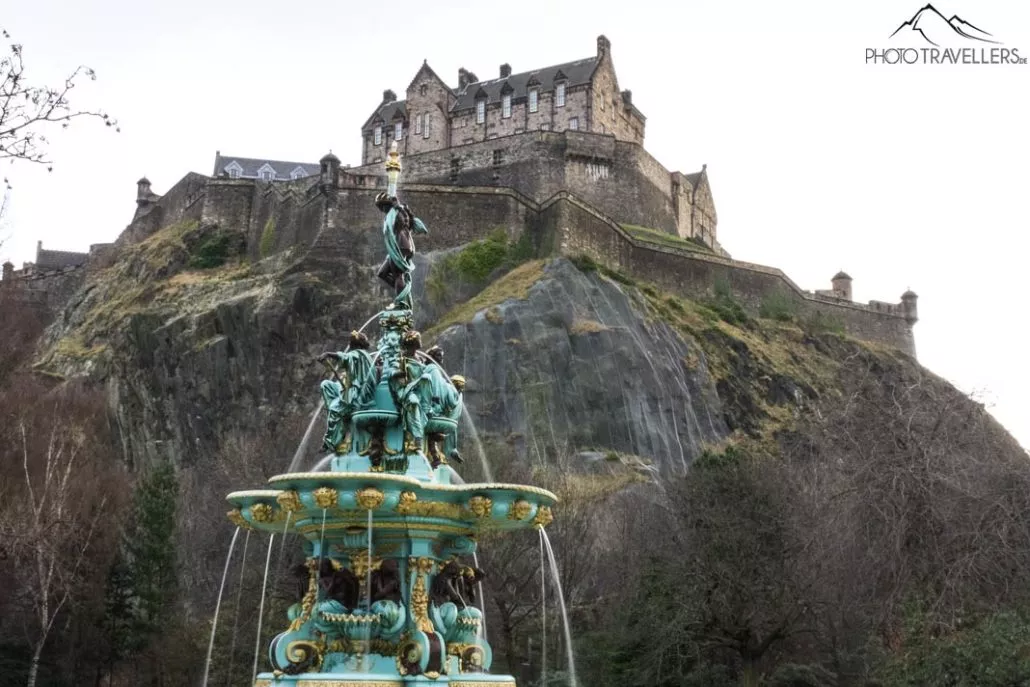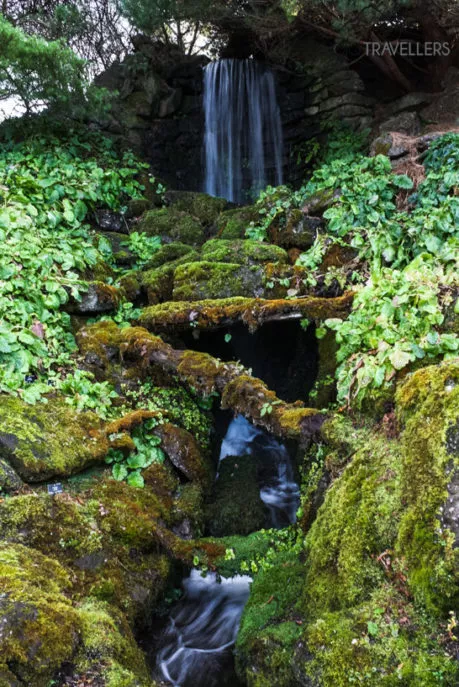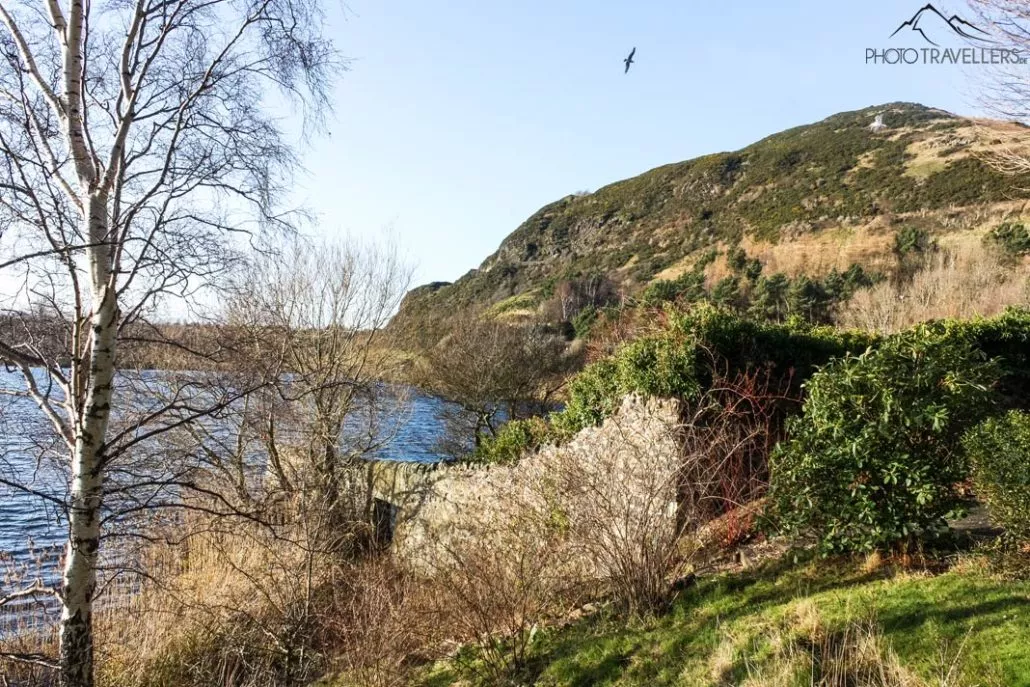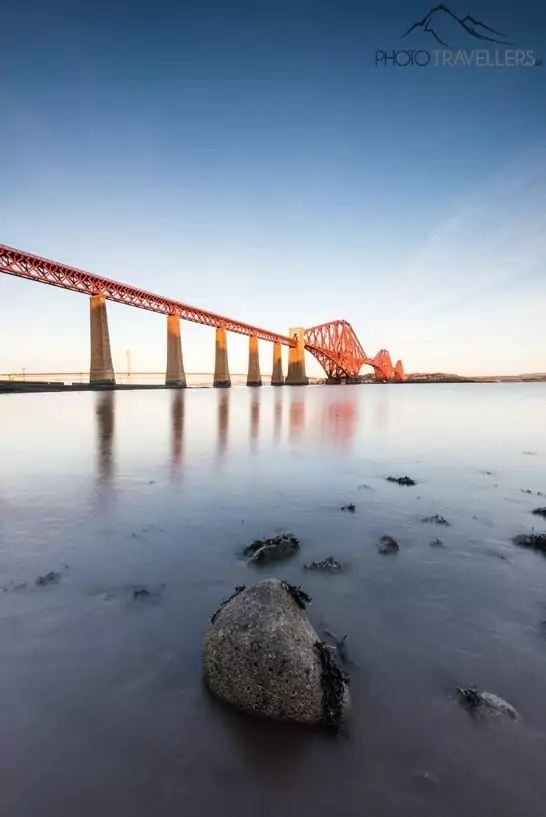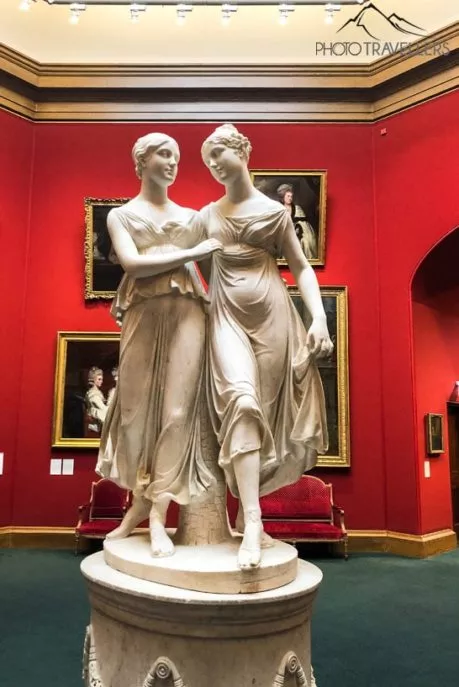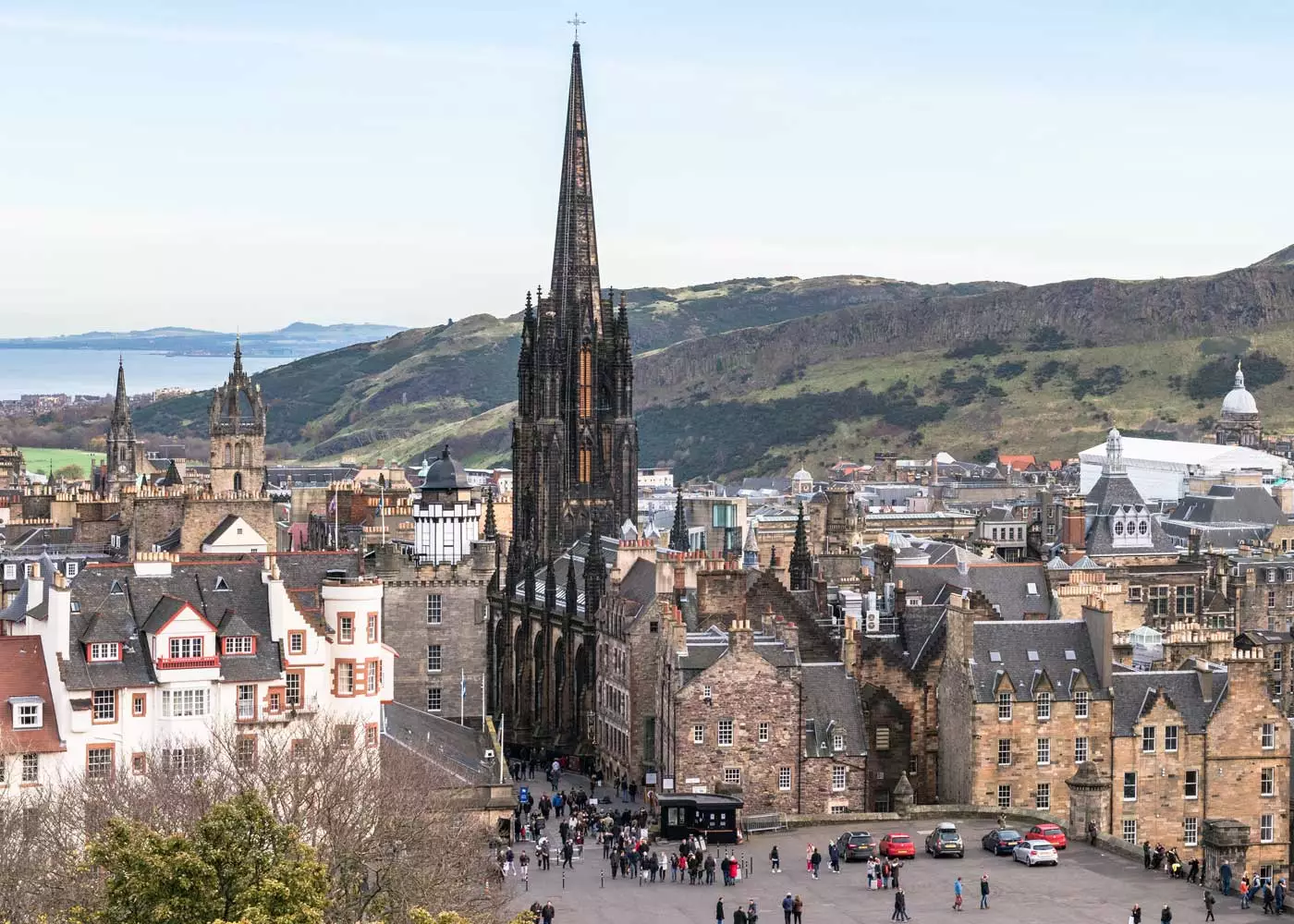
Top things to do in Edinburgh: 15 beautiful sights to see [+ map]
Edinburgh offers its visitors beautiful sights. We have been to Scotland many times and explored the area. But Edinburgh really captivated us. You should definitely not miss the Harry Potter city. The old town is also a UNESCO World Heritage Site.
In this article, we will show you the most important sights that you should not miss. We will take you to the Forth Bridge, explore Edinburgh Castle, The Royal Mile, St Giles' Cathedral, Calton Hill, Arthur's Seat, The Old Calton Burial Ground, Scott Monument and much more.
In addition, of course, we discover the Harry Potter spots Elephant House, Greyfriars Kirkyard Cemetery, George Heriot School, i.e. Hogwarts, Victoria Street as Angular Alley, the Harry Potter Museum and drink butterbeer at The Dog House.

Hi! Wir sind Biggi & Flo
Wir nehmen dich als Reisejournalisten mit zu den schönsten Orten der Welt!
Werbehinweis: Alle mit einem * markierten Links sind Werbelinks.
The most beautiful sights to see in Edinburgh at a glance
The centuries-old Edinburgh Castle in the middle of the old town, which itself is a UNESCO World Heritage Site. The volcanic surroundings with Arthur’s Seat. And Victoria Street, which served as the inspiration for Diagon Alley from Harry Potter. These are just some of the reasons why Edinburgh is one of the most beautiful cities in Europe.
- Edinburgh Castle
- Holyrood Palace
- Arthur’s Seat
- Royal Mile with St Giles’ Cathedral
- Victoria Street
- Greyfriars Kirkyard
- Cockburn Street
- Scott Monument
- Princes Street Gardens
- Calton Hill
- Portobello Beach
- Royal Botanic Garden
- Royal Yacht Britannia in Leith
- Firth of Forth
- Edinburgh Museum
Map: All sights in Edinburgh
On our virtual map you will find all highlights in Edinburgh at a glance:
[mapsmarker map=”219″]
1. Edinburgh Castle
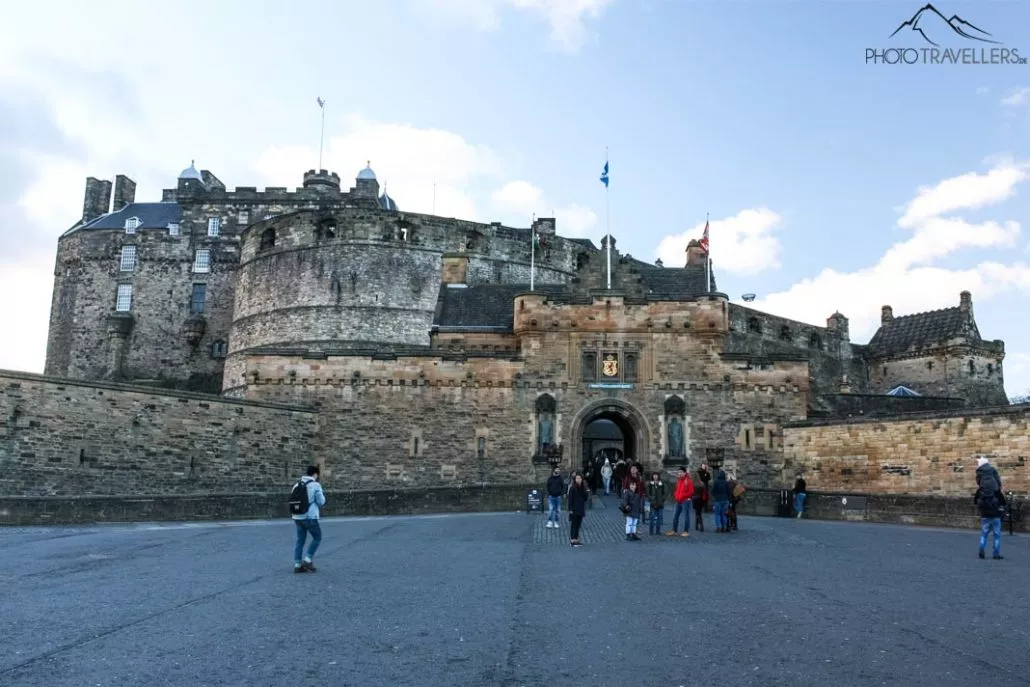
One of the most famous sights of Edinburgh is of course the name-giving castle, the Edinburgh Castle (Google Maps) on Castle Rock in the middle of the historic old town.
This rock formation was formed about 340 million years ago and is of volcanic origin. The first settlements existed here as early as the 9th century BC. When exactly the castle was built is not certain – however, it is assumed that a first fortress was built there in the 7th century. From the early Middle Ages at the latest, Castle Rock was then demonstrably inhabited.
Today you can enjoy a fantastic view of the city center with its historic buildings from Edinburgh Castle. You can even see all the way to the sea! The mighty cannons on the thick fortress wall also give you an idea of the brutal times that once ruled Scotland.
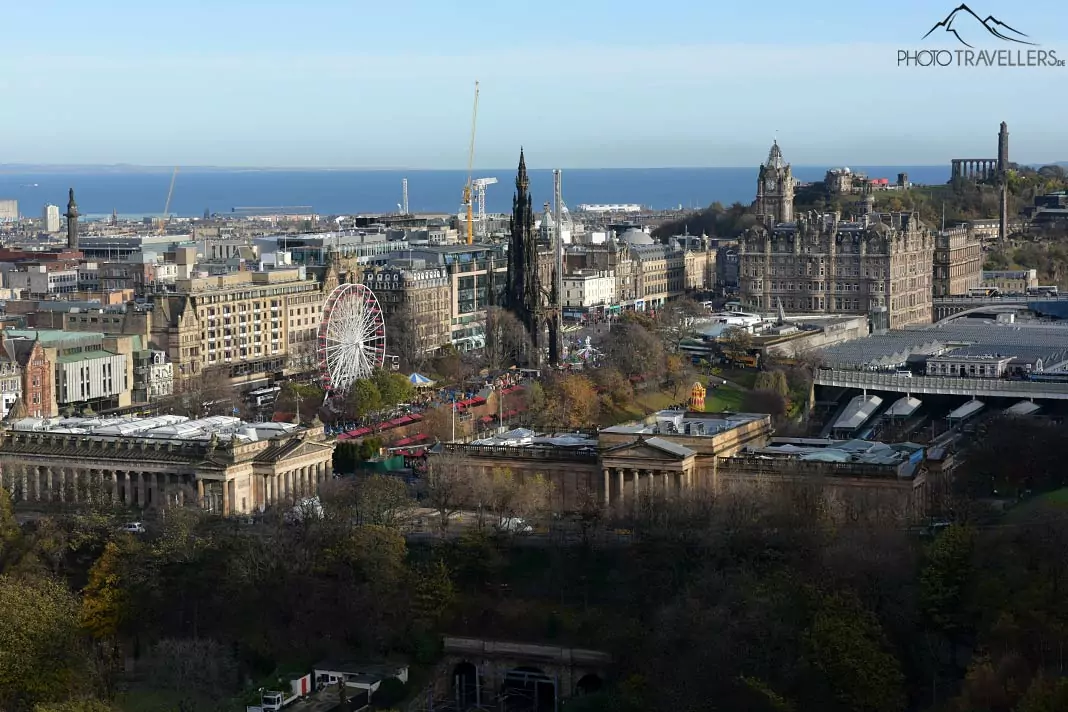
A highlight in the Edinburgh Castle are of course the Scottish Crown Jewels – an absolute attraction. As a visitor, you will be guided through the bloody history of Scotland in the exhibition until you see the Crown Jewels with your own eyes. Unfortunately, we can’t show you a photo of the Crown Jewels – photography is strictly forbidden in the small dark room.
Another thing to do in Edinburgh is the Scottish National War Memorial, which commemorates the Scottish dead of many wars. Here, too, photography is strictly prohibited. In the Great Hall the camera may be unpacked again. In this large hall official occasions are still celebrated today. You should also visit the Prisons of War, where pirates and other prisoners were imprisoned in the 17th and 18th centuries.
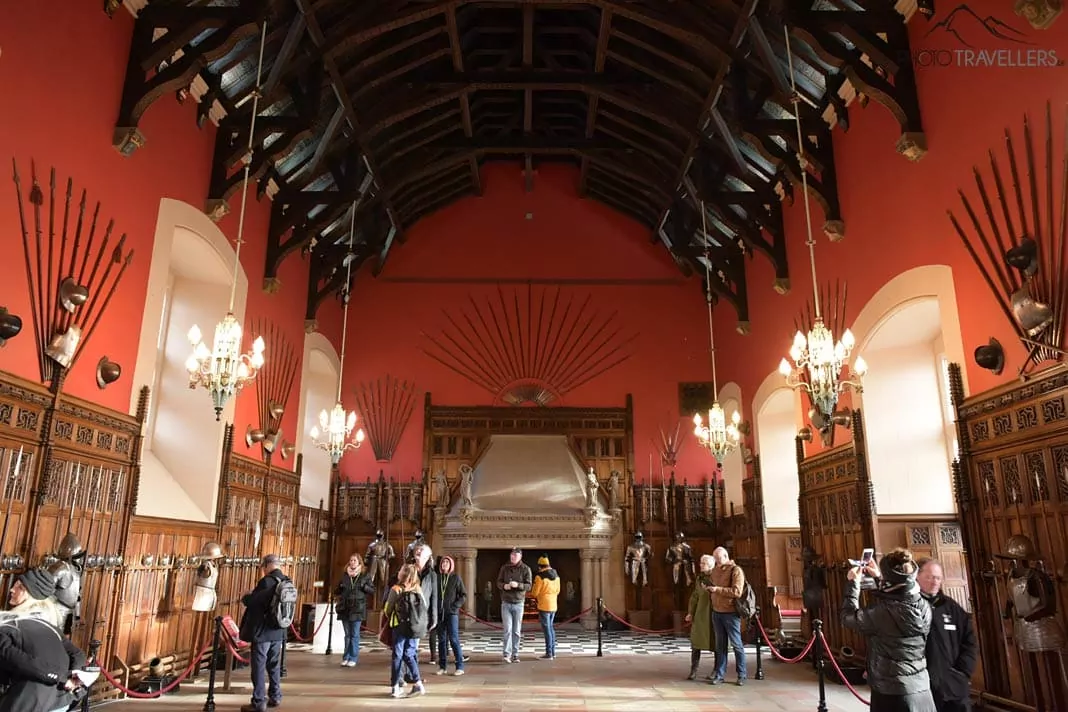 In the Great Hall at Edinburgh Castle
In the Great Hall at Edinburgh Castle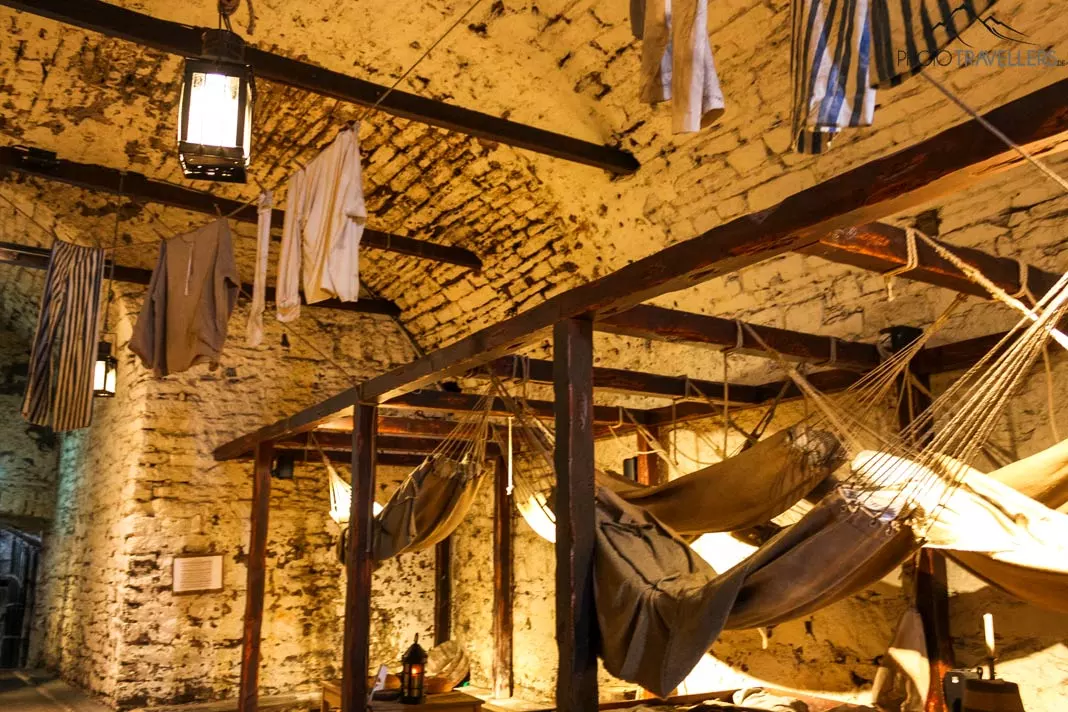 The Prisons of War are an exciting and historical place
The Prisons of War are an exciting and historical placeAn absolute highlight at Edinburgh Castle is the One o’clock Gun, which fires a shot every day except Sundays at 1 pm. Long ago, the sailors needed the bang of the gun as an exact time indication to adjust their chronometers. Today, of course, the whole thing is just a tourist attraction, but still a must-see in Edinburgh.
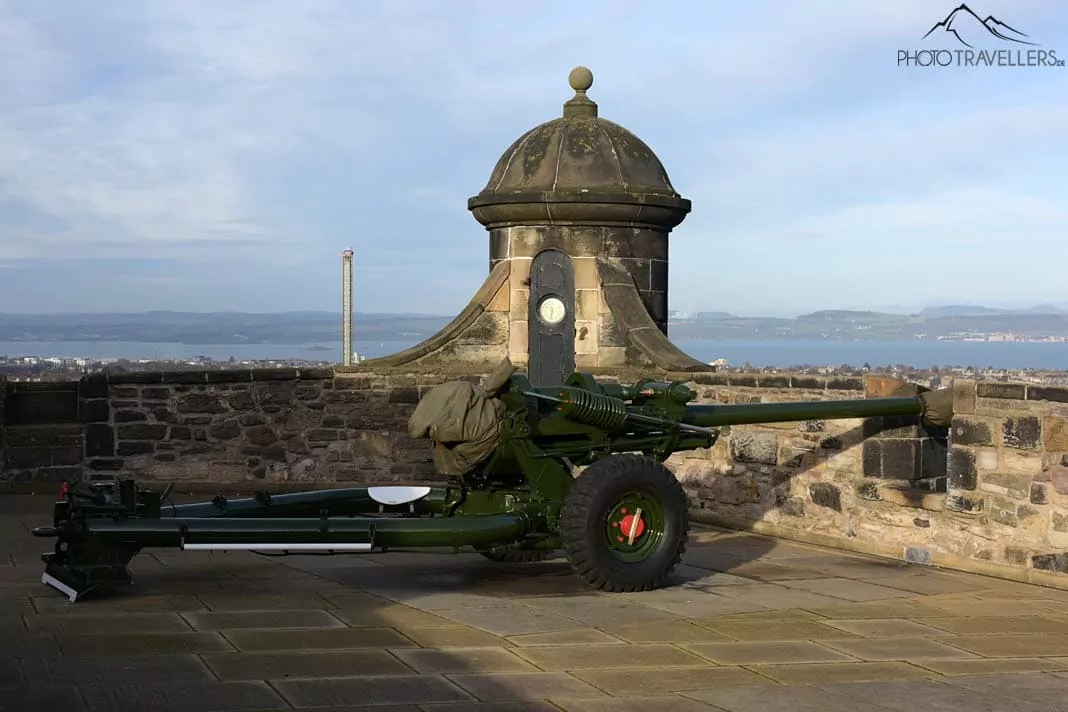
At the very top of the castle, you’ll find the small St Margaret’s Chapel, which dates back to the 12th century, making it the oldest surviving building in Edinburgh Castle. There you will also find another impressive cannon: the Mons Meg.
It is really incredibly huge and was the most powerful cannon of the 15th century. The exhibited specimen is the last preserved cannon of this type. Impressive are also the imposing cannonballs, which could be shot by the gun more than two kilometers away.
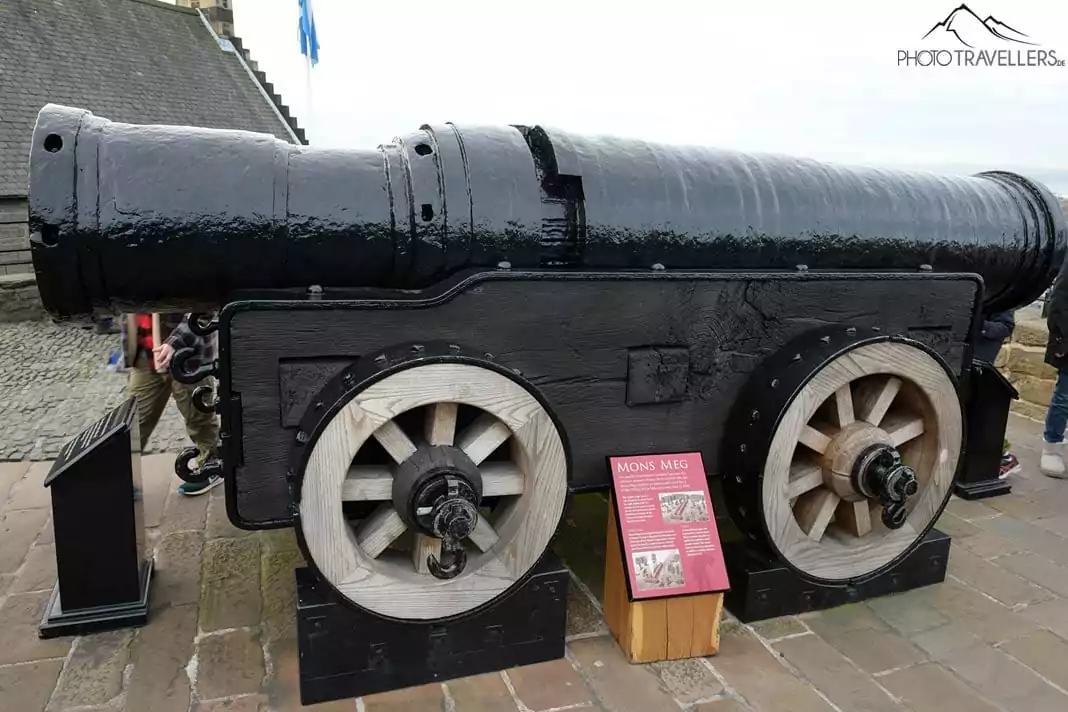
If you are in Edinburgh in August, another highlight awaits you. Directly in front of the castle, the largest music festival in Scotland, the Edinburgh Military Tattoo, takes place. The highlight is the performance of the Massed Pipes and Drums, a formation of about 200 bagpipers and drummers.
Tip: As you can see, Edinburgh Castle is not only worth seeing within the fortress walls. The castle also dominates the entire skyline of the city and is an excellent photo motif. One of the most popular viewpoints of the castle is a steep alley with many steps called The Vennel (Google Maps).
All Infos:
Castlehill, Edinburgh (Google Maps)
daily 9:30 till 17 o’clock
Adults pay 18.00 pounds
busstop at “Princess Street”
2. Holyrood Palace
Edinburgh Castle is not the only royal residence in Edinburgh. For example, when the Queen visits, she is very likely to be found at Holyrood Palace (Google Maps), which was designated the official residence of British monarchs in Scotland in the 1920s.
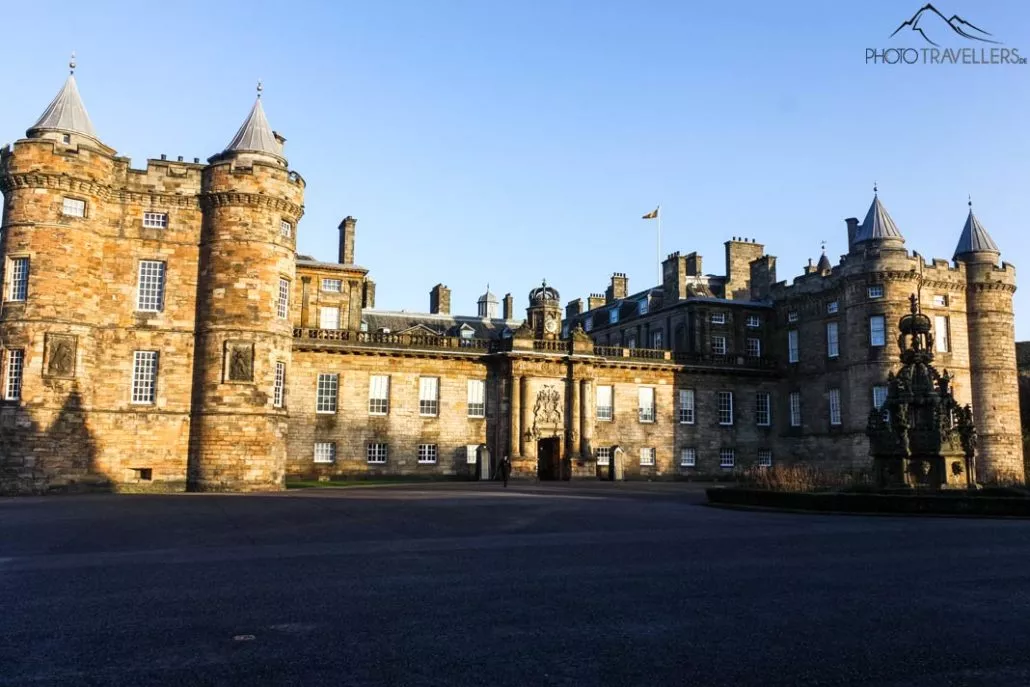
The palace was built starting in 1501 on the site of an abbey, Holyrood Abbey, which was founded in 1128. This is where the name of the residence comes from. When David I, King of Scotland in 1128, was hunting, he came across a stag and was startled. Suddenly a holy cross appeared, which saved him from an attack of the stag. In gratitude, he founded the abbey and named it after this event.
Today’s Holyrood Palace, officially called Palace of Holyroodhouse, was then gradually built. In the 1560s, for example, the northwest tower was added, which was inhabited by Mary Stuart aka Mary Queen of Scots. And in the 17th century, the palace acquired its current appearance with the addition of a fourth wing and the resulting mix of Renaissance and Baroque architecture.
Speaking of Mary Queen of Scots, her rooms are one of the highlights of the guided tour of Holyrood Palace, which you can take with an excellently designed audio guide. For example, as you climb the stairs to Mary’s former chambers, you’ll learn how she witnessed the murder of her private secretary – ordered by her jealous second husband Lord Darnley.
During the tour, you will gain further exciting insights into the dining room, the throne room and the gallery, where a total of 111 portraits of Scottish monarchs hang and large banquets are held.
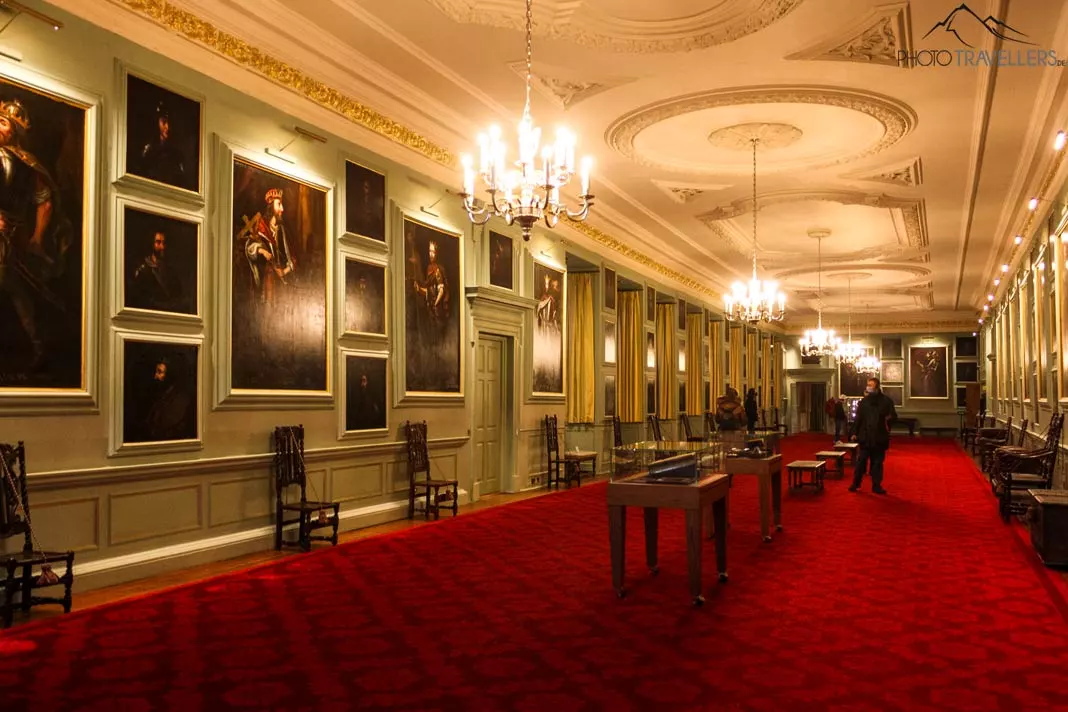 A stunning thing to see in Edinburgh is the Great Gallery which is the largest room in Holyrood Palace – the ceiling here is over 6 meters high
A stunning thing to see in Edinburgh is the Great Gallery which is the largest room in Holyrood Palace – the ceiling here is over 6 meters high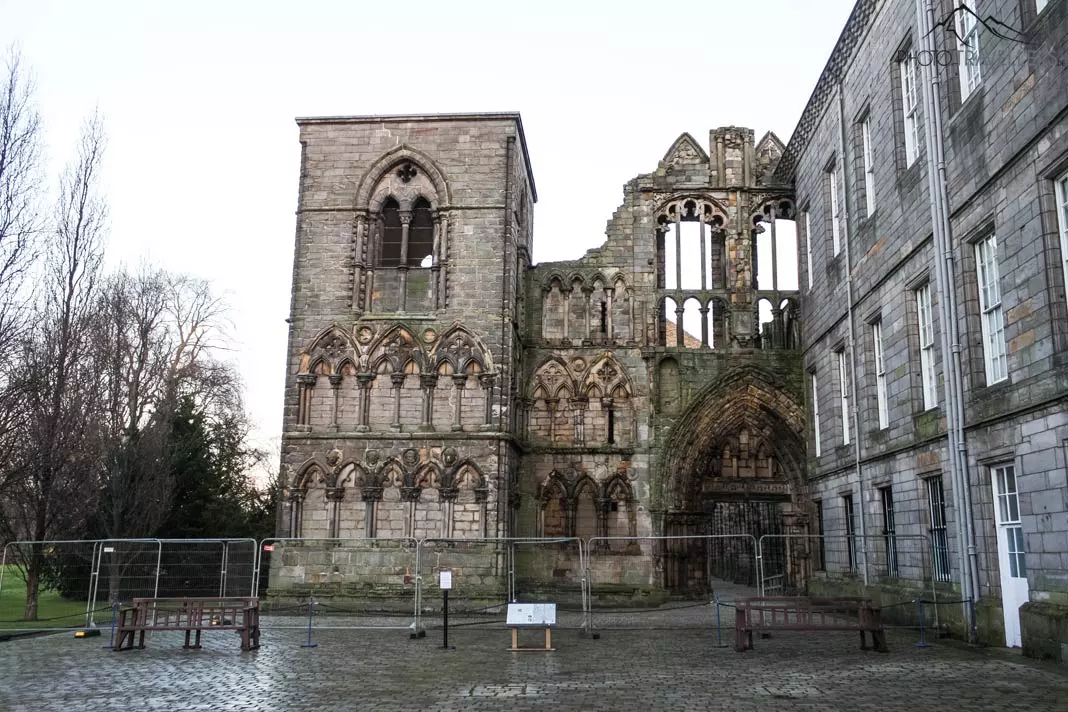 These are the remains of the original Holyrood Abbey, built in 1128 by King David I- a beautiful place to visit
These are the remains of the original Holyrood Abbey, built in 1128 by King David I- a beautiful place to visitIn addition, you can still admire the ruins of the old Holyrood Abbey on the grounds of the palace and take a walk through the palace grounds to enjoy the gardens and the view of the adjacent Holyrood Park – more about that in a moment.
First, an exciting fun fact: we already know that Holyrood Palace is the official residence of the British royal family in Scotland. In fact, the Queen stays here at least once a year – in June, when the famous Holyrood Week takes place and the Queen hosts garden parties with up to 8,000 guests.
Incidentally, opposite Holyrood Palace is the Scottish Parliament, which decides on regional affairs. The striking parliament building was designed by a Catalan architect and inaugurated by Queen Elizabeth II in 2004.
All Infos:
Canongate, Edinburgh
(Google Maps)
daily 9:30 till 16:30 o’clock, Tuesday and Wednesday closed
Adults pay 17.50 pounds (September-June), 18.50 pounds July-August
In June, the Queen resides at the palace
3. Arthur’s Seat
Adjacent to Holyrood Palace is Holyrood Park (Google Maps), a 260-hectare area formerly used for royal hunting- a impressive thing to do in Edinburgh.
Characteristic for the park is not only the yellow blooming broom, but above all the hilly and rocky terrain, which strongly reminds of the Scottish Highlands and goes back to volcanic activity 300 million years ago. For example, you can see the Salisbury Crags from far away. These are 46 meter high cliffs that form a mesa and offer great views of Edinburgh.
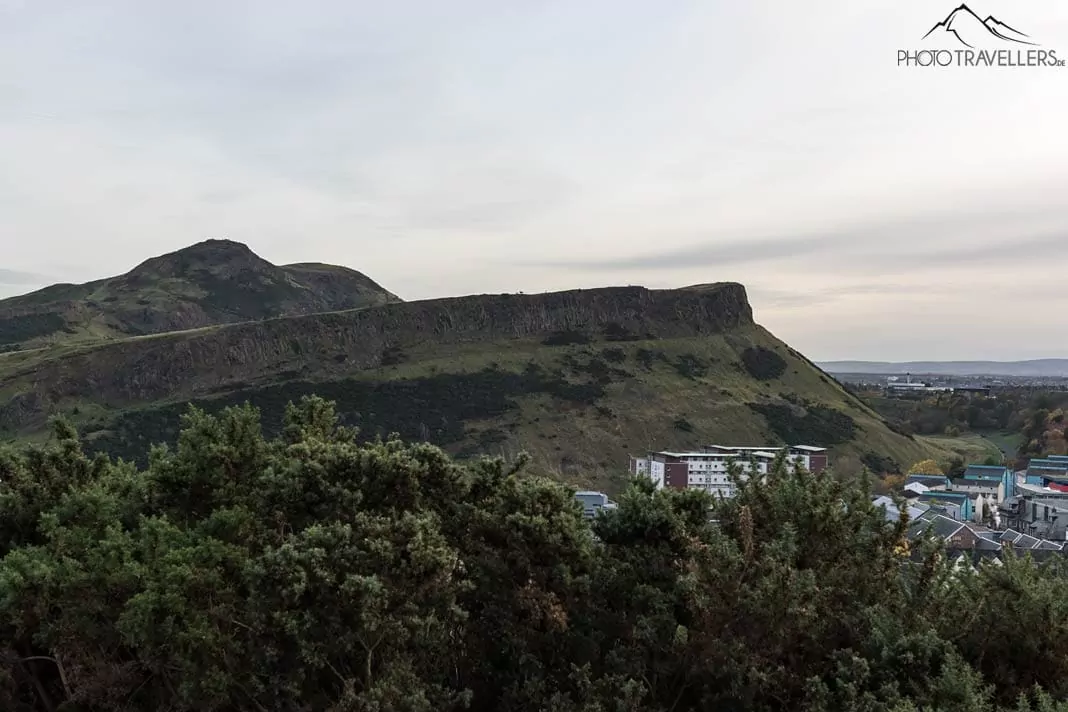
Also hidden in Holyrood Park is St Margaret’s Loch, a real insider tip. Two other lochs, Dunsapie Loch and Duddingston Loch, are also part of the extensive grounds. Unfortunately, the famous Loch Ness is a bit further away – about five hours by car from Edinburgh.
The star of Holyrood Park, however, is undoubtedly Arthur’s Seat. Edinburgh’s local mountain is 251 meters high and consists of a solidified lava dome from the Carboniferous period, as is the rock formation that forms the basis of Edinburgh Castle.
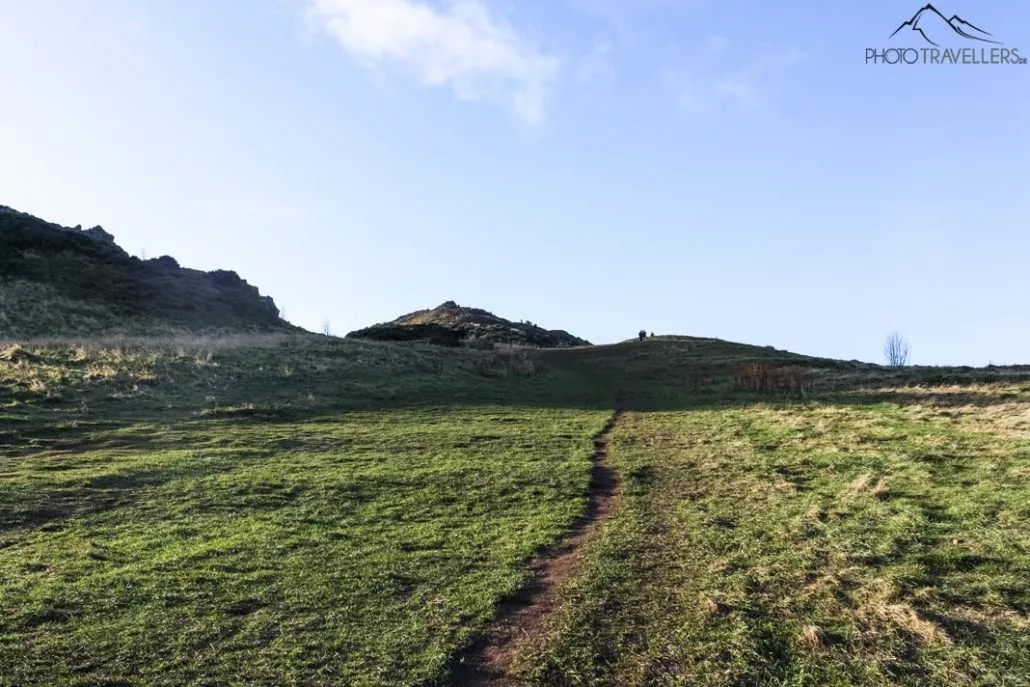
If you have the time, you should definitely climb to the top of Arthur’s Seat. There are several ways: a long one over the Salisbury Crags, a steep one over the southwest side or the probably easiest one over the east side at Dunsapie Loch. However, it is also very uneven in places – good shoes and enough time are essential here.
In addition, it is usually extremely windy at the summit. This is also true for the highest point of the Salisbury Crags – but the view is just as good and the path not quite as difficult. I personally prefer the Crags to Arthur’s Seat!
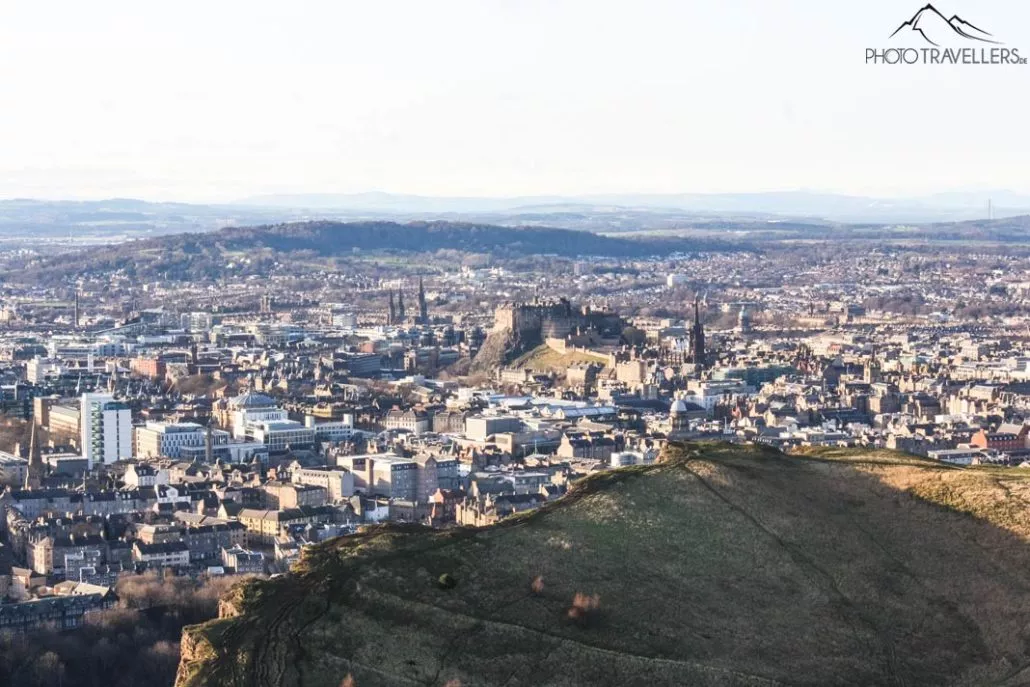
However, I have withheld one exciting piece of information about Arthur’s Seat from you, because the mountain holds a spooky secret. In 1836, 17 small coffins were discovered here in a crevice, inside of which lay small wooden dolls. To this day, it is not clear what it is all about. Of course, many myths and theories surround it – in the vernacular they are called “fairy coffins” and many suspect a connection to the notorious serial killers Burke and Hare, who killed in Edinburgh in the 19th century.
Eight of the 17 coffins can be seen today in the National Museum of Scotland, about which you will read more later on. The location of the remaining coffins is unclear.
⭐ The perfect travel guide for your Edinburgh trip
For your trip to Edinburgh, we highly recommend the Lonely Planet Pocket Guide (get it here*). Also very nice to know is Fodor’s Essential Scotland (get it here*).
4. Royal Mile with St Giles‘ Cathedral
From our excursion into the countryside, we return to the historic Old Town. You already know Edinburgh Castle and Holyrood Palace there. Exactly between the two sights runs another top attraction of Edinburgh: The Royal Mile (Google Maps).
This street is so named because it connects these two royal castles and is also about a mile long. It is also called High Street and is a tourist hotspot. Pageants and parades also often take place here.
If you start from Edinburgh Castle and walk down the Royal Mile, you will see the picturesque building of the former Highland Tolbooth Church from a distance. However, the church moved out in 1979. Built between 1839 and 1844, the building now serves the city as an event venue under the name “The Hub.” The church’s stately appearance dominates the cityscape and continues to be a top landmark.
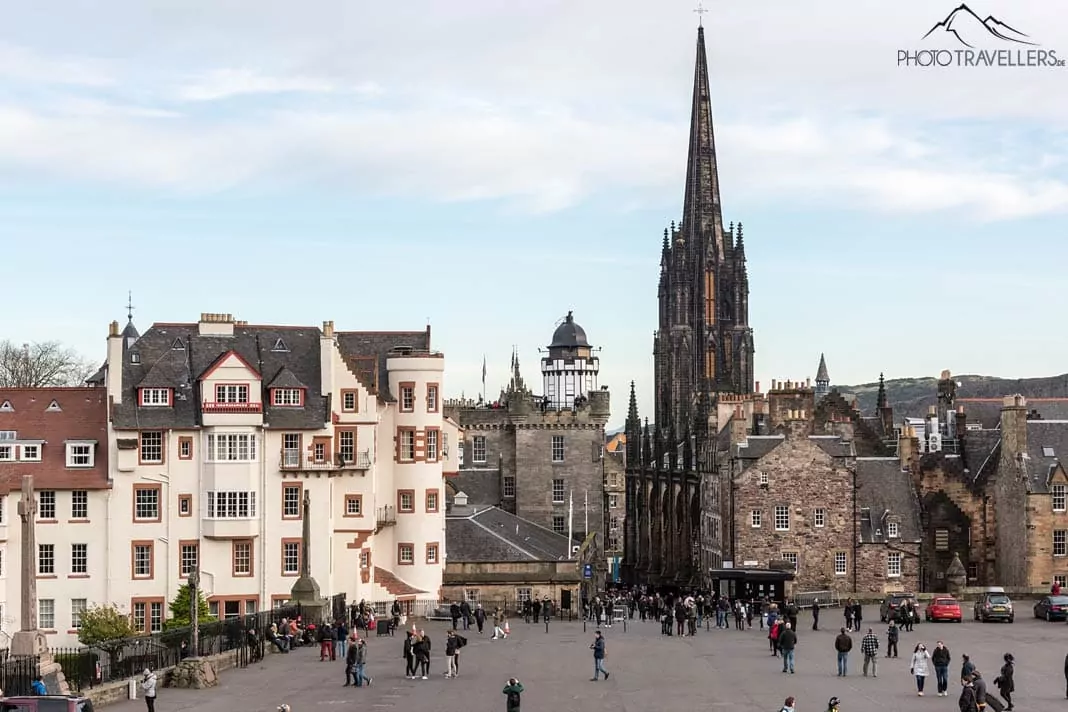
A little further down the “royal mile” the next church is already waiting. It is St Giles’ Cathedral, the main church of the Church of Scotland. Already in the year 854 a church stood at this place, as a document from that time proves. A special feature is hidden in the parking lot behind the cathedral – there used to be the cemetery where the Scottish reformer John Knox was buried. Today, only a relatively inconspicuous plaque in parking bay 23 bears witness to this.
St Giles’ Cathedral burned down in its long history, but was rebuilt again and again. The striking stained-glass windows date only from the late 20th century. The Icelandic artist Leifur Breidfjörd was behind them. Supposedly, the interior of the church also served as a model for J.K. Rowling’s Harry Potter. The huge hall at Hogwarts is said to have been inspired by it.
Information: To be allowed to take pictures of the sights in the church, you have to pay 2 pounds.
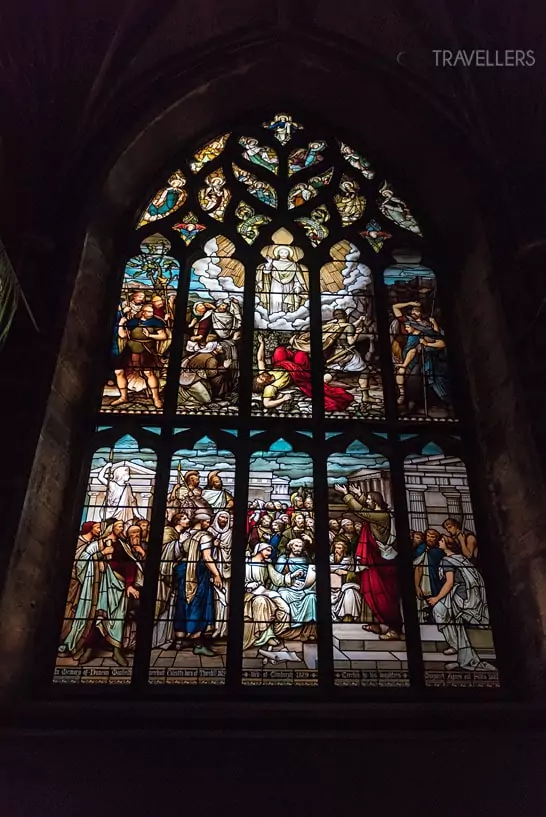
But speaking of John Knox, even further south on the Royal Mile is a house where the reformer is said to have lived briefly in the 16th century. Today, therefore, John Knox House houses a small museum on the Reformation and life in Edinburgh 400 years ago.
Across from The Hub, The Little Inn café catches our attention. A small sweet store where we order delicious sandwiches and drink chocolate. Just what we need in these icy November temperatures.
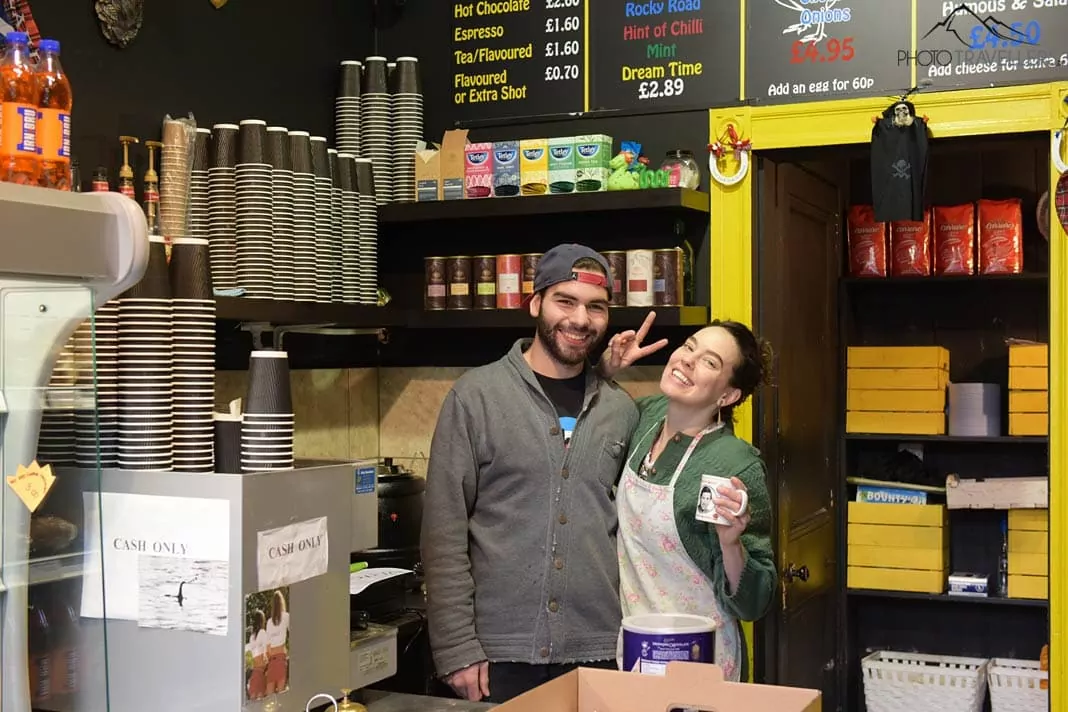
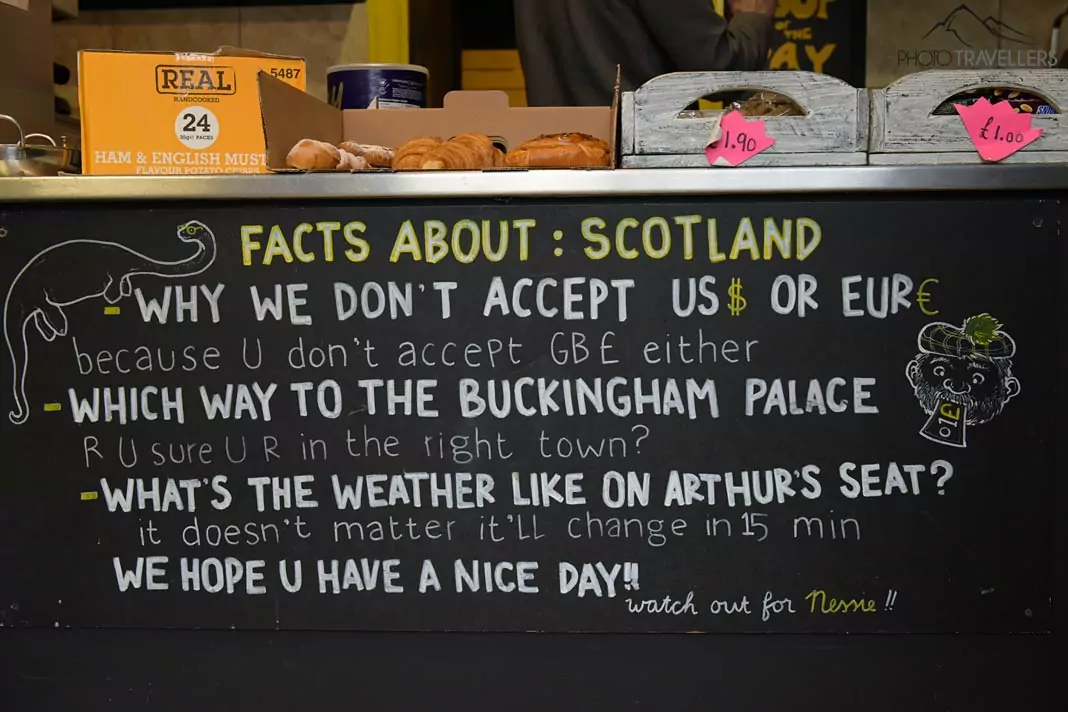
5. Victoria Street
Not far from the Royal Mile is arguably one of Edinburgh’s most beautiful streets: Victoria Street (Google Maps). A fun thing to do in Edinburgh!
The eye-catching design of Victoria Street is based on the Flemish style and is characterized by colorful facades, sweeping arches and cobblestones. Behind the colorful paint hide exciting little stores – for example, a small cheese store, a sweet café or a real Scottish jeweler.
At the same time, Victoria Street still retains the charm of bygone times. Between the buildings, you repeatedly come across small and medieval alleys that lead to more or less hidden places.
Approximately in the middle of the street, for example, there is a passageway that leads to the top via a stone staircase. This is the upper floor of Victoria Street, which is called Victoria Terrace. It houses more stores and restaurants. However, it also opens up a whole new perspective and a fantastic view of Victoria Street below, as well as other sights such as George Heriot’s School, which we’ll learn more about in a moment.
Victoria Street is not only famous for its beautiful architecture and picturesque location, but also for the Harry Potter book series. The street is said to have served as inspiration for J.K. Rowling’s Diagon Alley. After the author had already written the novels in Porto in the early 1990s, she moved to Edinburgh in 1993 and found all kinds of inspiration for the magical wizarding world there.
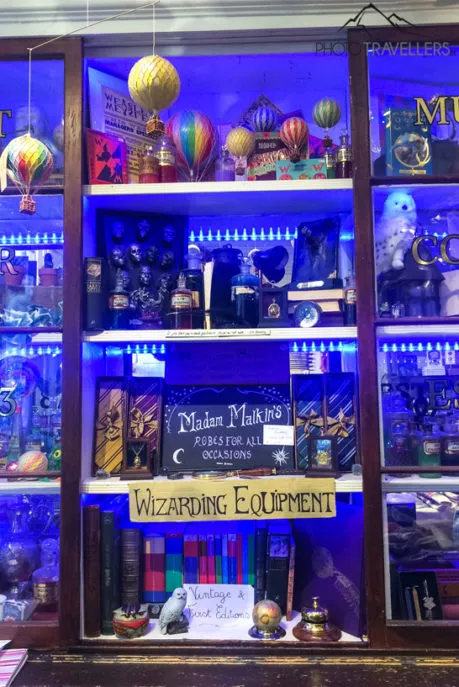
At 40 Victoria St, you’ll find a store today that’s designated as a Harry Potter museum. It’s well worth a visit. Other spots for Harry Potter fans in Edinburgh are The Elephant House café, where J.K. Rowling wrote the plot of her idea on napkins, or the luxurious Balmoral Hotel, where the author later stayed – today her old room with the number 552 is even called The J.K. Rowling Suite.
And for the hardcore fans, you can try Butterbeer at The Dog House (Google Maps)!
6. Greyfriars Kirkyard
Also, at the top of the list of Harry Potter inspirations is Greyfriars Kirkyard (Google Maps)- a top thing to do in Edinburgh.
This is where J.K. Rowling seems to have gotten ideas for some of the names of her characters. For example, you’ll find the graves of Anne Potter or Thomas Riddell – the latter might have been the inspiration for the infamous Lord Voldemort, who was born Tom Riddle. William McGonagall, who became famous as the worst poet of all time, is also buried here and was the namesake of the popular Gryffindor tutor. If you look around the cemetery, you’re sure to find more tombstones that remind you of names from Harry Potter!
Right next door, in fact, is a building that is responsible for one of the most central building blocks of Harry Potter: Hogwarts School of Witchcraft and Wizardry. This is supposed to be based on George Heriot’s School, which is right next to the Greyfriars Kirkyard. Because there are also four houses here in the colors green, white, red and blue – very similar to the four Hogwarts houses.
What will probably also catch your eye at Greyfriars Kirkyard are the iron bars over some of the tombs. They were there in the early 18th century to stop body snatchers – this trade was widespread at the time, as fresh corpses were needed for medical purposes and were worth a lot.
Finally, though, here’s a slightly nicer, or at least touching, story: that of Bobby the Greyfriar. He was a terrier in the 19th century who remained faithful to his master even after his death. After his master died, Bobby came to his grave every day for 14 years, until he finally passed away himself to his old age. Both Bobby and his master John Gray are buried in the cemetery. Also, a statue was built for Bobby in front of Greyfriars Kirkyard – touching his nose brings good luck, by the way.
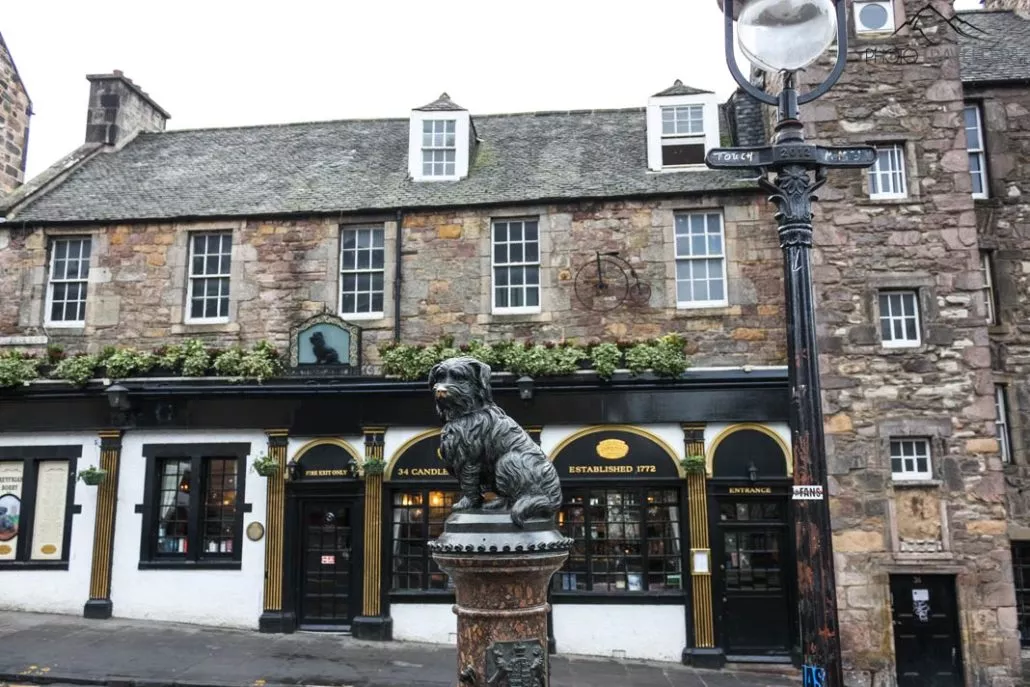
Tip: Another famous cemetery in Edinburgh worth visiting is the Old Calton Burial Ground (Google Maps). Here you will find not only a huge obelisk, but also the mausoleum of David Hume and adjacent to it the old Calton prison.
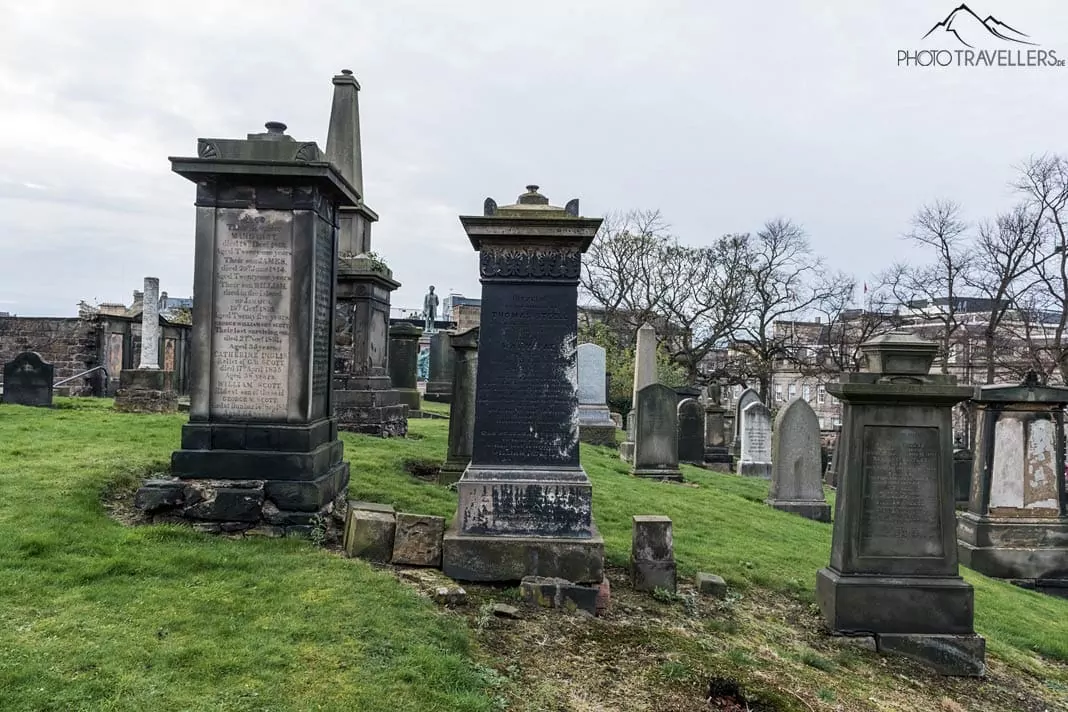
7. Cockburn Street
Besides Victoria Street, there is another picturesque street that you must see. Cockburn Street (Google Maps) branches off the Royal Mile and descends steep curves to Waverley Station, Edinburgh’s main train station.
Here you will also find, among other things, a Harry Potter store and other small stores that are worth discovering. For example, you should stop by Loch Fyne Whiskies, the branch of a whisky distillery from the north of Scotland. My tip: the Chocolate & Orange Liqueur tastes great and is also suitable for whisky beginners.
By the way, the street is named after Lord Cockburn, a respected judge from the 19th century. He was committed to building streets like Cockburn Street in a sustainable way, so as not to harm the environment or the historic cityscape.
Lord Cockburn’s likeness still adorns the entrance to 1 Cockburn Street, where it was carved in stone above the door and thus immortalized. There, by the way, is the office of the Edinburgh Military Tattoo, which we already got to know in the section about Edinburgh Castle. One more important information: the “ck” of Cockburn is not pronounced – so it is called “Co-burn”.
Filmmakers have also been enthralled by the beauty of Cockburn Street in the past. In 2017, for example, scenes for the popular film Avengers: Infinity War were shot here.
Last but not least, from Cockburn Street you also have an excellent view of the next landmark: the Scott Monument. What this Edinburgh landmark is all about, you’ll find out right after this!
8. Scott Monument
Arriving at the lower end of Cockburn Street, we find ourselves at Waverley Station. It was named after the title of the first novel by Sir Walter Scott, a very famous and successful Scottish writer. A huge monument was also dedicated to him, which can be found right next to the station: the Scott Monument (Google Maps).
Today, it is not only one of Edinburgh’s landmarks, but with a height of 61 meters, it is also the largest of many monuments in Scotland to Sir Walter Scott. It is also the second largest monument ever erected to a writer. Only the José Martí Monument in Havana is even taller.

The construction history of the Scott Monument is also curious. After the death of Sir Walter Scott in 1832, a competition was held to find the best design for the monument. However, the best design came from a person who had participated under the pseudonym John Morvo – this was a well-known architect in the Middle Ages. Eventually it turned out that behind it was George Meikle Kemp. However, he had not dared to compete with his real name, as he was not a trained architect.
Nevertheless, everyone was so enthusiastic about his proposal that he won the competition and signed the contract to build the monument in 1838. The foundation stone was laid in 1840 and then in 1846 the monument could be solemnly inaugurated.
It consists of a large stone tower, which is accessible and leads over 287 steps to the highest of several viewing platforms. However, there is a small fee for this.
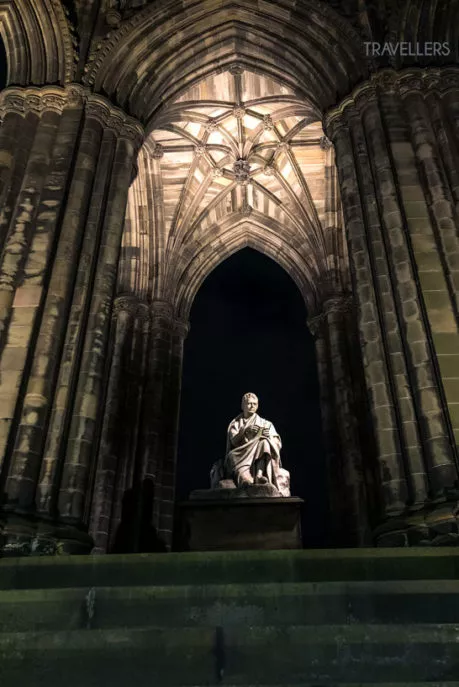
In the center of the tower is a statue of Sir Walter Scott, showing him with his writing utensils and his dog Maida. It is made of white Carrara marble and was designed by John Steell. However, you should take a close look not only at the beautiful statue, but also at the rest of the monument, because it is decorated with a total of 64 figures and characters from Scott’s novels, all of which were created by Scottish sculptors.
9. Princes Street Gardens
Directly behind the Scott Monument is Edinburgh’s main shopping street, Princes Street. It separates the Old Town from the New Town, that is, the historic Old Town from the newer part of Edinburgh.
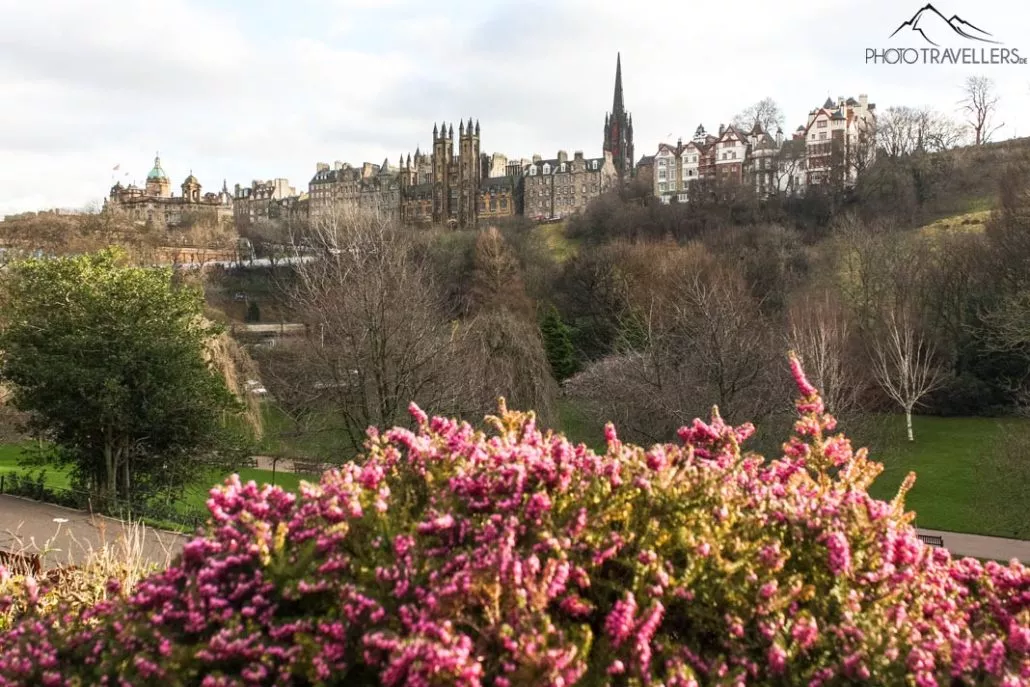
the public park of the same name. In its place there used to be the Nor Loch lake, into which all the sewage from the higher-lying Old Town flowed – after all, there was no sewage system back then. The lake was drained for the construction of the New Town and formed the ideal, nutrient-rich basis for the park, which is therefore particularly green today.
The Princes Street Gardens are located at the foot of the Edinburgh Castle and open up great views of the castle and the historic center of the city. Not least because of this, the Princes Street Gardens have become a popular meeting place. Concerts and festivals also take place here, for example during Hogmanay, the Scottish New Year celebrations.
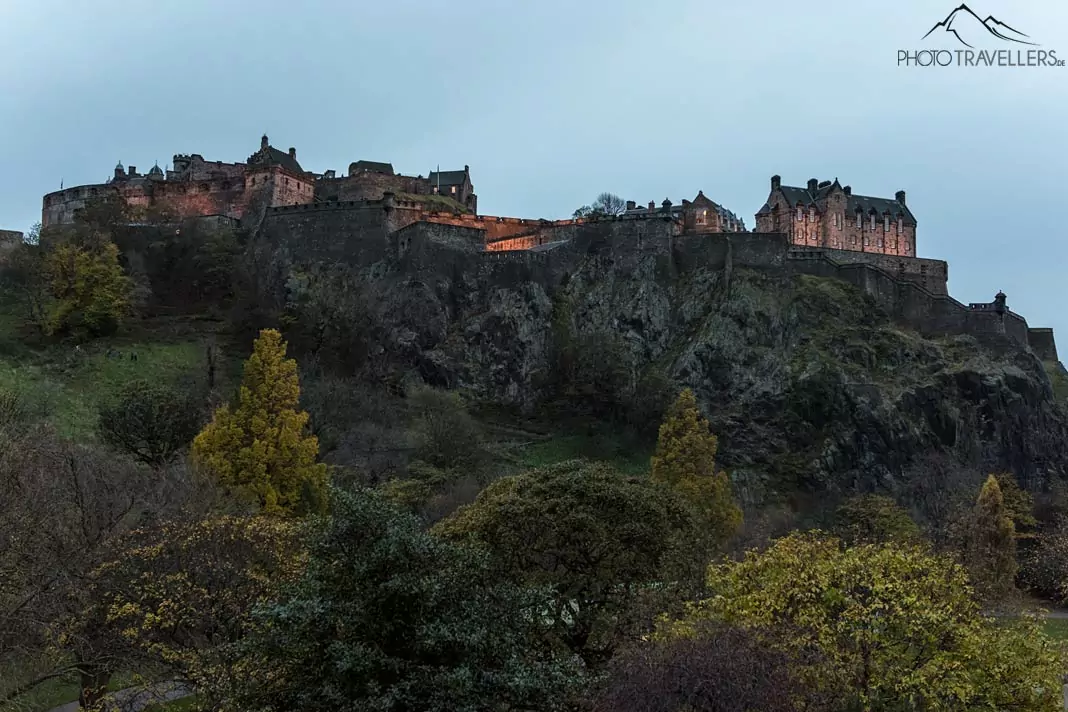
In Princes Street Gardens you will find several monuments and sculptures, an open-air stage, a war memorial and a flower clock that is redesigned every year. The clock has been around since 1903 – in fact, at the time it was the only flower clock in the world.
An insider’s tip in the gardens of the Princes Street is the pretty Head Gardener’s Cottage. It’s also known as Great Aunt Lizzie’s House because scenes from the popular British children’s series Teacup Travels were filmed here, where the main character Aunt Lizzie lives.
You must also make a stop at the Ross Fountain, located at the western end of Princes Street Gardens. It’s a 19th-century iron fountain that features several (mermaid) women. Four of them embody science, the arts, poetry and industry.
The fountain had already been exhibited at the Great Exhibition in London in 1862 before it came to Edinburgh. For this, it had to be disassembled into no less than 122 individual parts! By the way, it was named after the Edinburgh arms manufacturer Daniel Ross, who had discovered and purchased it at the exhibition.
10. Calton Hill
Do you remember the Old Calton Burial Ground? I’ve already introduced you to this cemetery as a tip. It is located at the foot of Calton Hill (Google Maps), which at 103 meters is one of Edinburgh’s most prominent elevations.
If you follow the steps out of Regent Road, you’ll get to the “top” of Calton Hill. However, it’s actually more of a plateau, with several neoclassical monuments and buildings on it.
Among the highlights is the Dugald Stewart Monument, dedicated to the Scottish philosopher of the same name. It has the shape of a Greek temple and was inspired by the Lysicrates Monument in Athens. However, the monument is really impressive only in combination with the background of Edinburgh.
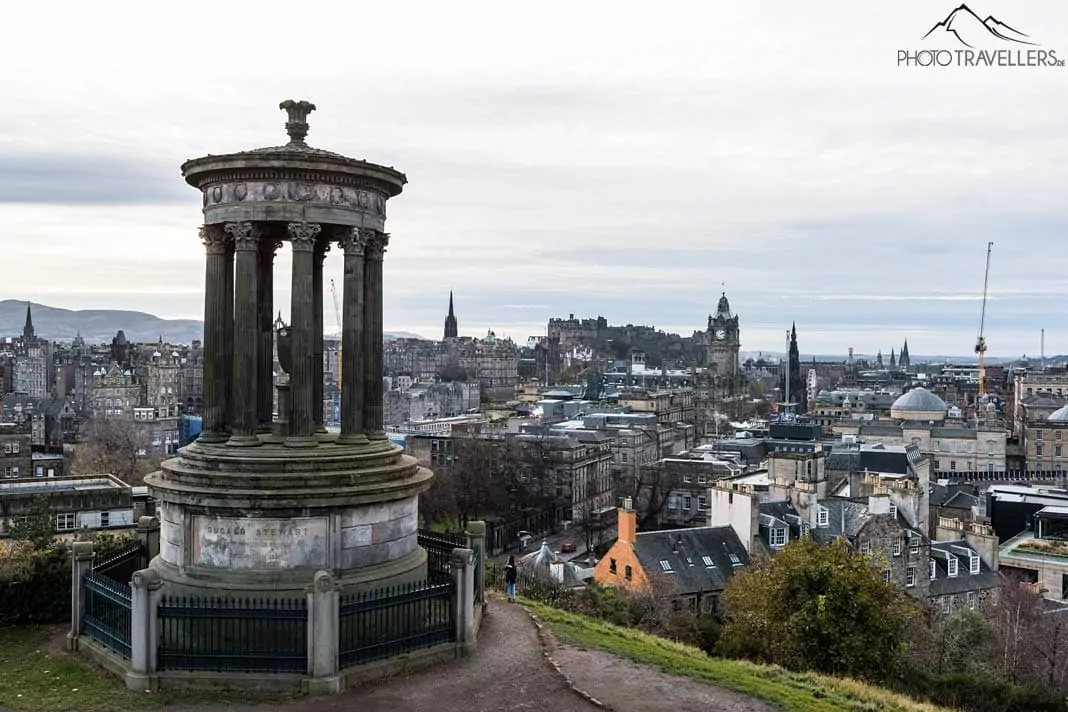
The National Monument of Scotland was also designed by the architect of the Dugald Stewart Monument, the Scotsman William Henry Playfair. It is located only a few meters away, also on Calton Hill. Here, also, ancient Greece served as inspiration – in this case, the Parthenon. However, the budget was not sufficient: the national monument, which was intended to commemorate the fallen of the Napoleonic Wars, remained incomplete and is today considered a building sin.
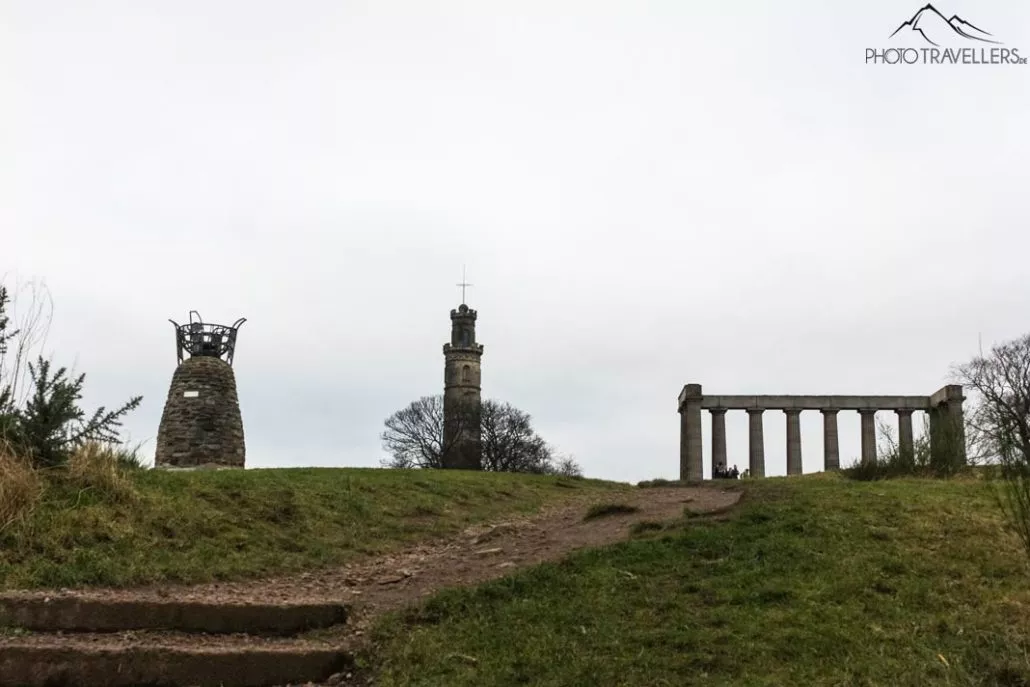
Another landmark on Calton Hill is the Nelson Monument. It stands at the highest point of the hill and is dedicated to Horatio Nelson, a British admiral who won several important naval battles in the 18th century. At the top of the tower is a time ball that signals the time.
Finally, on Calton Hill you will find the Edinburgh City Observatory. It was once the city’s largest observatory before it was replaced by the Royal Observatory due to high light pollution. It has since been converted into the famous Collective, a contemporary art gallery. There are various exhibitions, guided tours and events there.
However, Calton Hill is probably best known for its breathtaking panoramic views. So explore the various viewpoints of Leith Harbour, the Firth of Forth, Edinburgh’s historic Old Town and Arthur’s Seat here.
11. Portobello Beach
A Hidden Gem that is nevertheless one of the absolute top sights is Portobello (Google Maps) – a relaxing thing to do in Edinburgh.
The small town nicknamed “Porty” was once completely independent, but is now considered a suburb of Edinburgh. Portobello is located about five kilometers east of the city center.
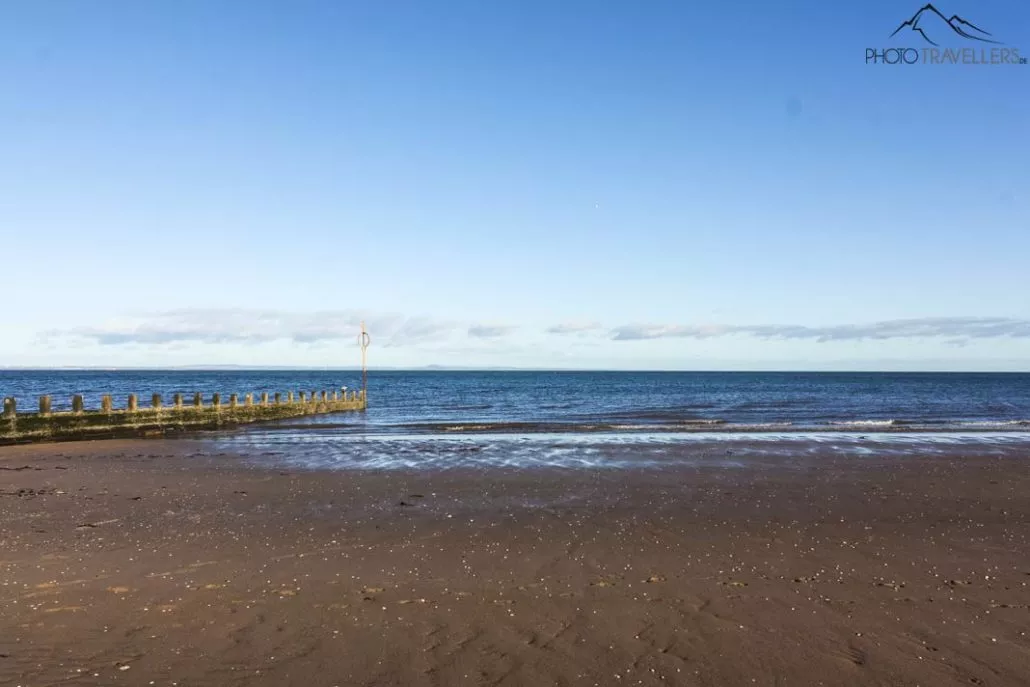
The place is located directly on the Firth of Forth, an inlet of the North Sea. Since Roman times, Portobello, then called Bodotria, has been a popular seaside resort. Even today, the almost 2 kilometer long sandy beach is a popular destination – and not only in summer! At New Year’s, for example, one of the many Loony Dooks takes place here, where thousands of people (often dressed up) venture into the ice-cold water.
I also dared to go into the water at Portobello Beach for about 30 seconds in January. With an outside temperature of 8°C and a water temperature of about 6°C, it was really icy, but an unforgettable experience. I personally can only recommend: Do it!
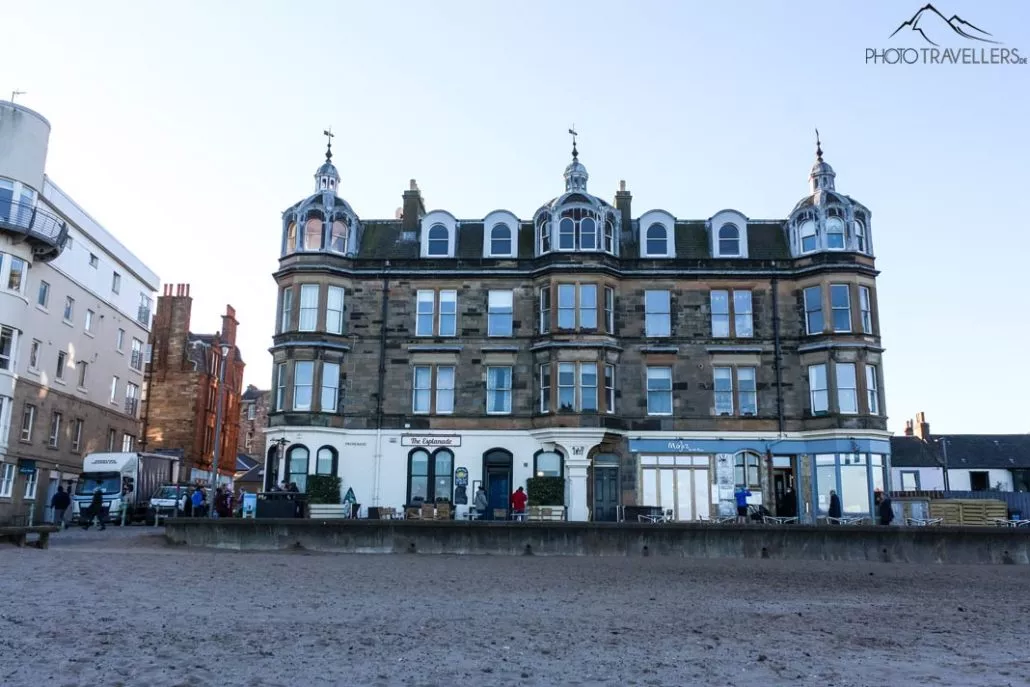
If that’s a bit too cold for you, you can still walk along the beach, collect shells and enjoy the great view. Or you can simply sit down in one of the many cafés on the beautiful promenade of Portobello, which enchants with its Georgian and Victorian buildings along the sandy beach.
By the way, you can get to Portobello Beach quickly and easily by bus, for example with lines 26, 45 or 124, which stop at Portobello Highstreet, which is directly connected to the beach via Bath Street.
12. Royal Botanic Garden
From the blue, it’s straight on to the green. The Royal Botanic Garden Edinburgh (Google Maps), is one of the most beautiful green oases in the Scottish capital.
It was founded as early as 1670 for the cultivation of medicinal plants. This makes it the second oldest botanical garden in the United Kingdom – only the botanical garden at Oxford University is older. Even today, the Royal Botanic Garden of Edinburgh is not only a tourist attraction, but above all a scientific institution.
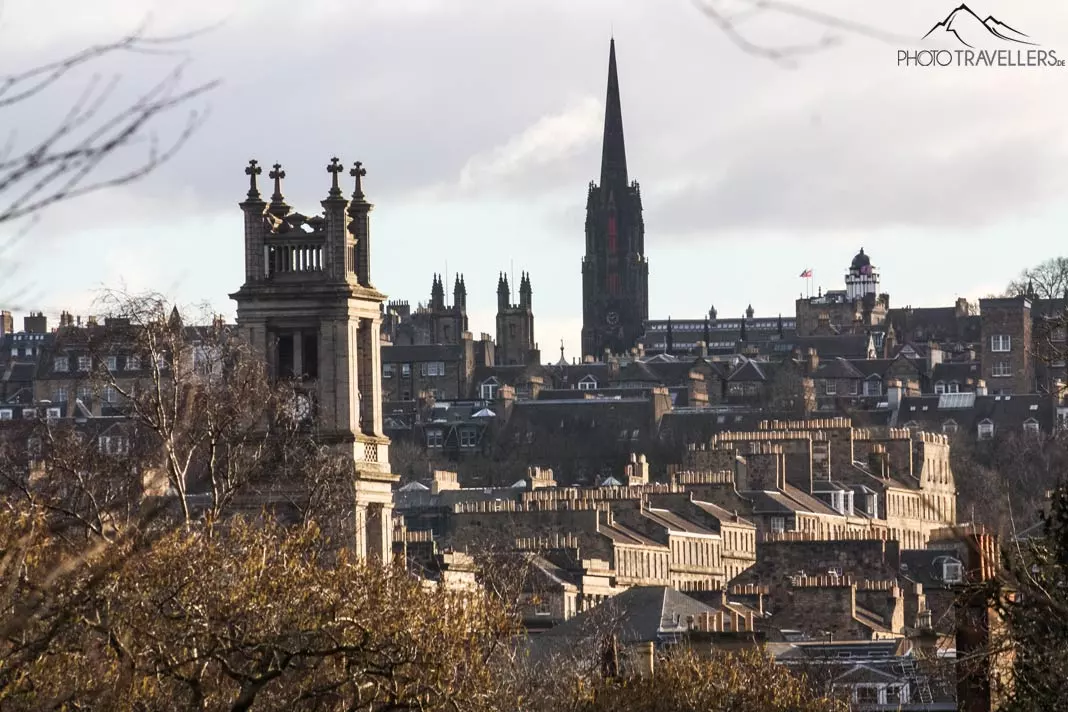 The Royal Botanic Garden Edinburgh is not only a great destination…
The Royal Botanic Garden Edinburgh is not only a great destination…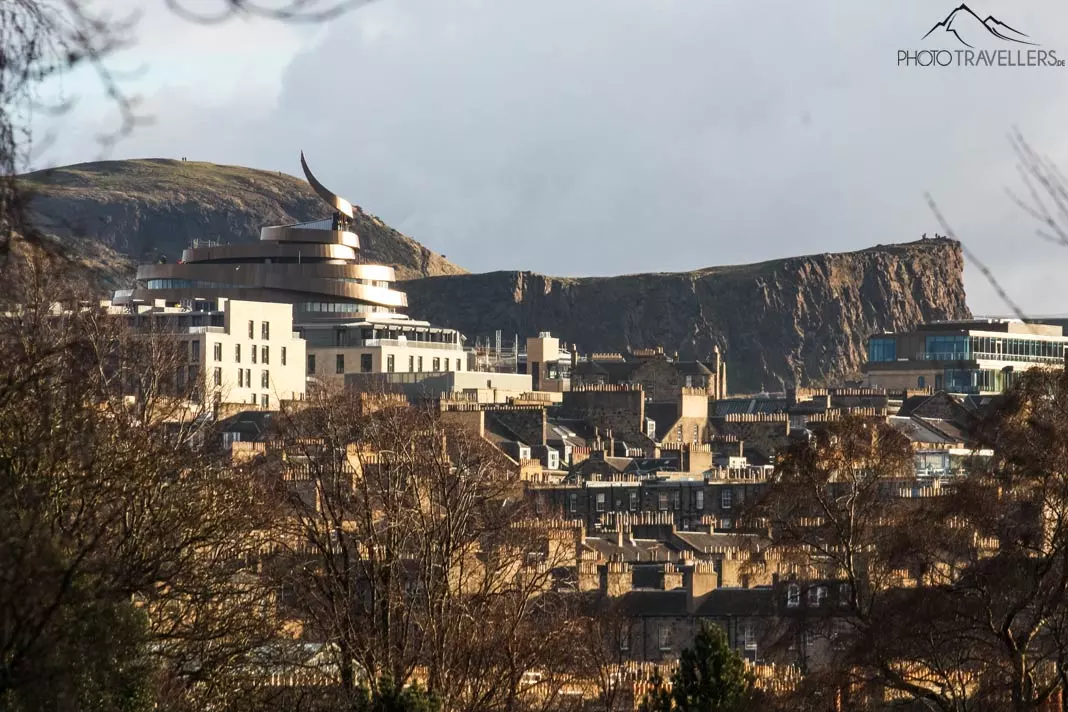 …but also holds spectacular views such as these- a top thing to do in Edinburgh!
…but also holds spectacular views such as these- a top thing to do in Edinburgh!The Royal Botanical Garden also has three other locations in Scotland: Dawyck, Logan and Benmore. But in Edinburgh alone, you’ll find more than 13,300 different plant species and a herbarium with more than 3 million dry-preserved plants.
One of the highlights of the Royal Botanic Garden is the Temperate Palm House, built in 1858, which is still the largest palm house in the UK.
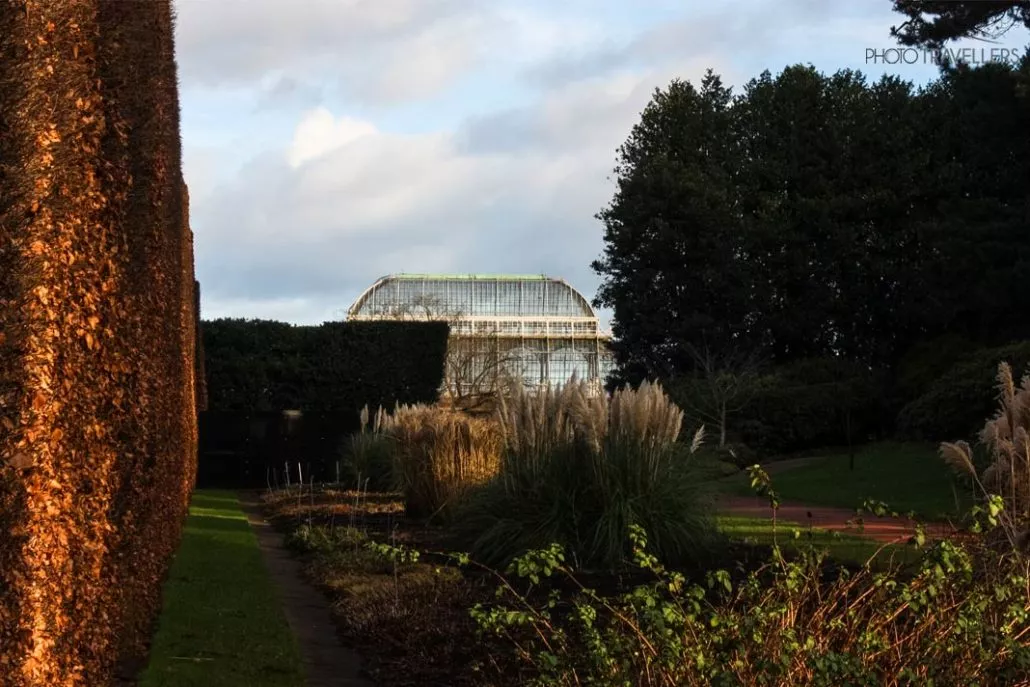
Another impressive building in the botanic garden is Inverleith House. It dates back to the 18th century and stands roughly in the middle of the large park grounds. It is now mainly used as an exhibition space for modern art.
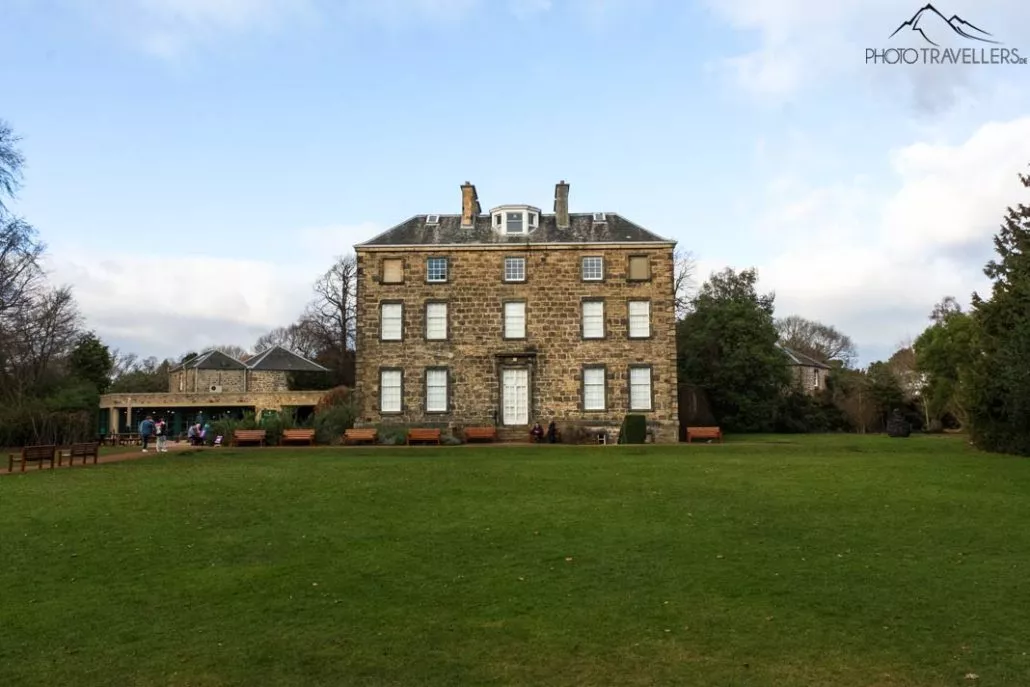
My personal highlight in the Royal Botanic Garden, however, is the Rock Garden. Here, rocky landscapes have been recreated, which is why alpine plants in particular grow and thrive here. In total, there are even 5,000 different species! The whole thing is made even more spectacular by the waterfall, the resulting stream and the small lake.
Tip: A great alternative to the large Royal Botanic Garden is the very small, hidden Dr Neil’s Garden in the southeast of Edinburgh (Google Maps). It is located directly at the picturesque Duddingston Loch and is also called “Scotland’s secret garden”.
13. Royal Yacht Britannia in Leith
We continue in Leith (Google Maps), a district of Edinburgh. Similar to Portobello, Leith used to be an independent town, and in the 13th century it was even one of the most important ports in Scotland.
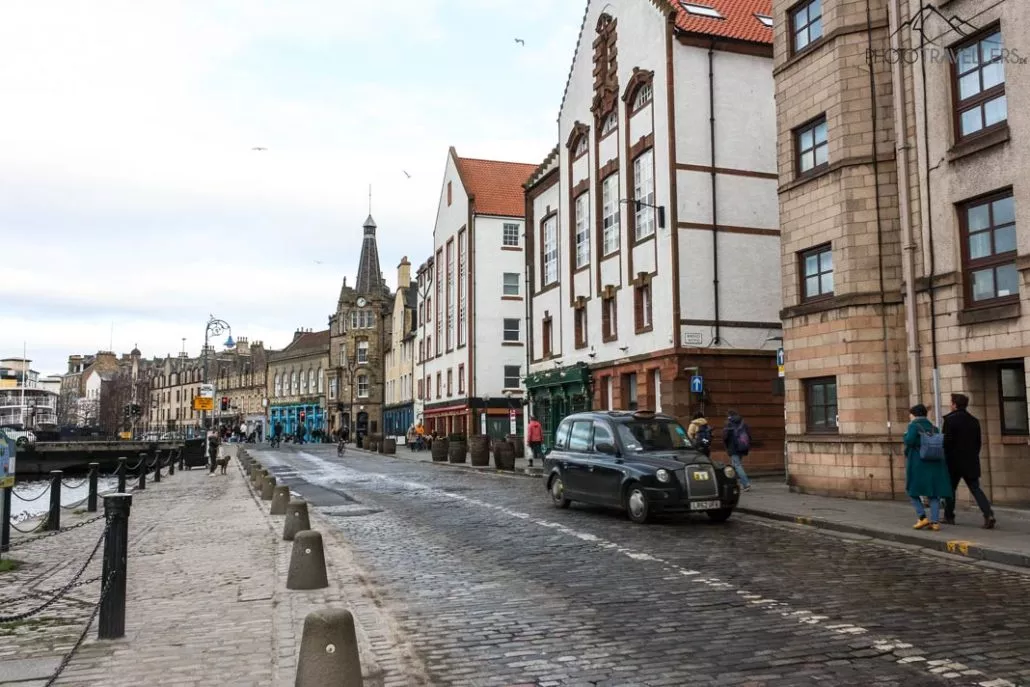
Later, Leith lost its importance and became a poor, run-down area. It was not until the end of the 90s that people began to invest in the district again and made it more attractive for tourists. Today, for example, more than 50 cruise ships dock in the port of Leith every year.
Also, among the redesign measures was the stationing of the Britannia in Leith. The Royal Yacht Britannia was the 83rd yacht of the royal family and traveled the world for some 40 years. The floating palace was in service from 1954 to 1997, transporting its passengers to 696 visits abroad and 272 at home. Prince Charles even spent his honeymoon with Diana on the yacht.
Today, the Britannia is anchored in Leith as a museum ship. You can take a look at the ship and learn about the history of the yacht and the royal family in a large exhibition. You will also get an insight into the rooms in which the royal family resided. For example, you can see the Queen’s bedroom and her favorite room, a veranda on the upper deck.
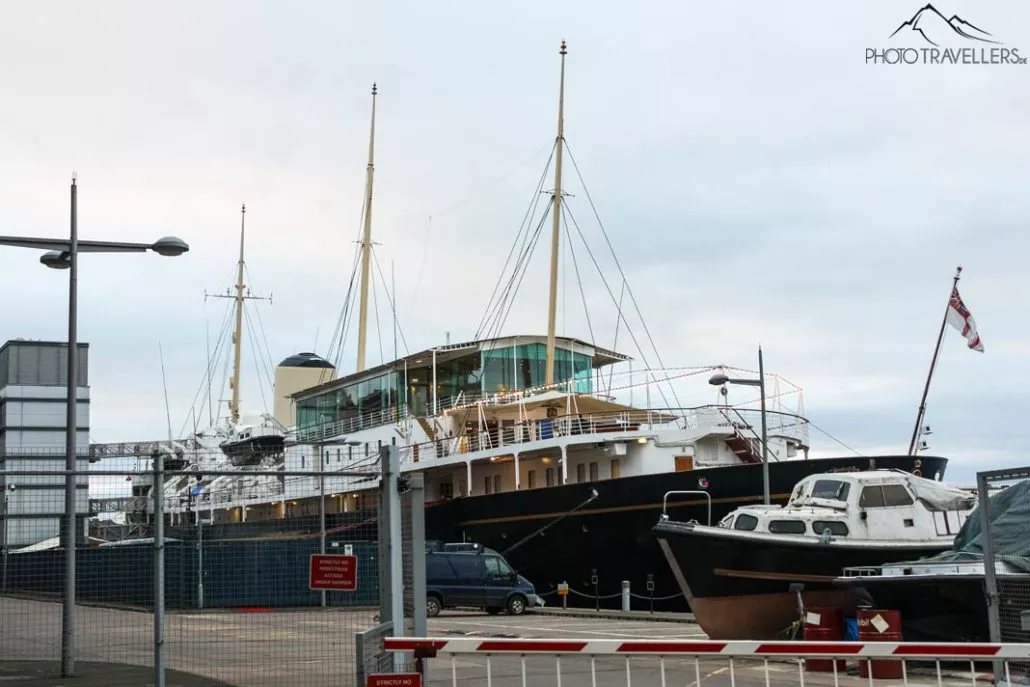
Also, worth seeing are the command bridge, the drawing room, the medical room, the ship’s galley and the ship’s bell. By the way, Queen Elizabeth really cared about the ship – although she is usually rather reserved in public, there was a small tear on her face when she disembarked for the last time on December 11, 1997.
Tip: If you’re ever this close to the sea, you shouldn’t miss out on a delicious portion of fish and chips. You can get the traditional dish at the beautiful Teuchters Landing (Website).
14. Firth of Forth
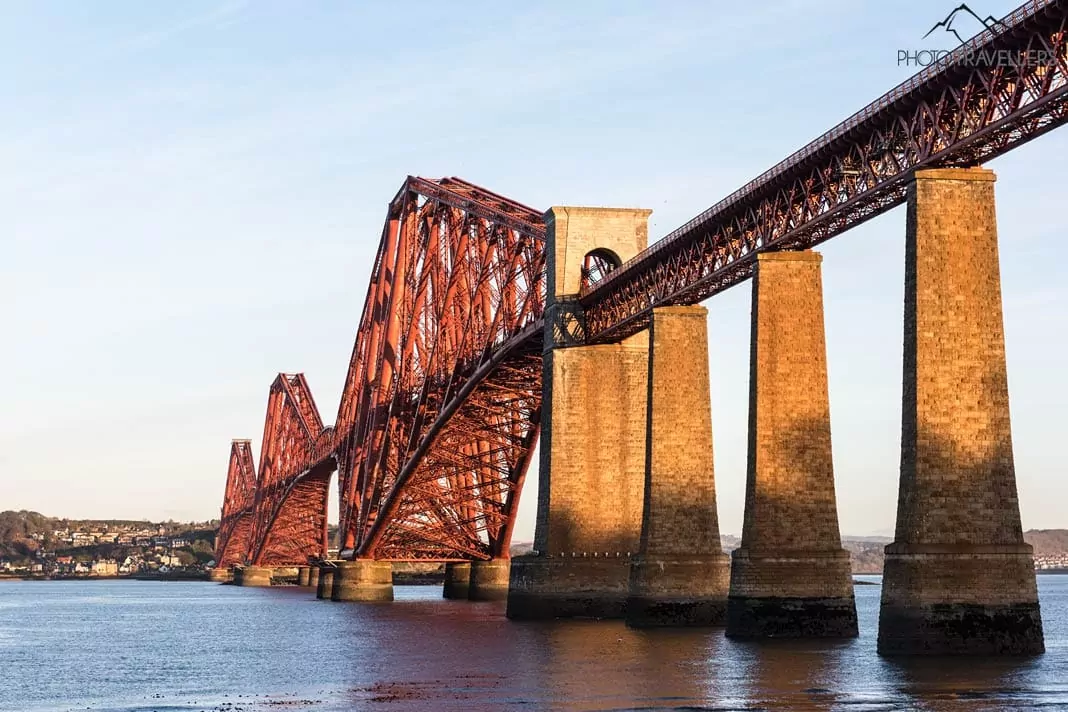
You can order this photo here
We’ve seen it a few times in the text, and you shouldn’t miss it in person either: The Firth of Forth (Google Maps).
The estuary forms the transition of the river Forth into the North Sea and shapes the landscape around Edinburgh. Geologically, by the way, the Firth of Forth is a fjord because it was formed during the Ice Age by the seaward-moving Forth Glacier. Who would have thought there was a fjord in Scotland?
But in addition to the great scenery of the estuary, there is something here that is considered an absolute landmark of the region. And that is the three Forth bridges west of Edinburgh near the airport. Each of them reflects a century and is unique in its own way.
Probably best known is the Forth Bridge, which immediately catches the eye with its red curved design. It is 2523 meters long and was built between 1823 and 1890 – 40 years before the Golden Gate Bridge in San Francisco. In its time, the structure was the longest bridge in the world and a technical marvel. It was also the first bridge to be made entirely of steel, in contrast to the wrought iron used until then.
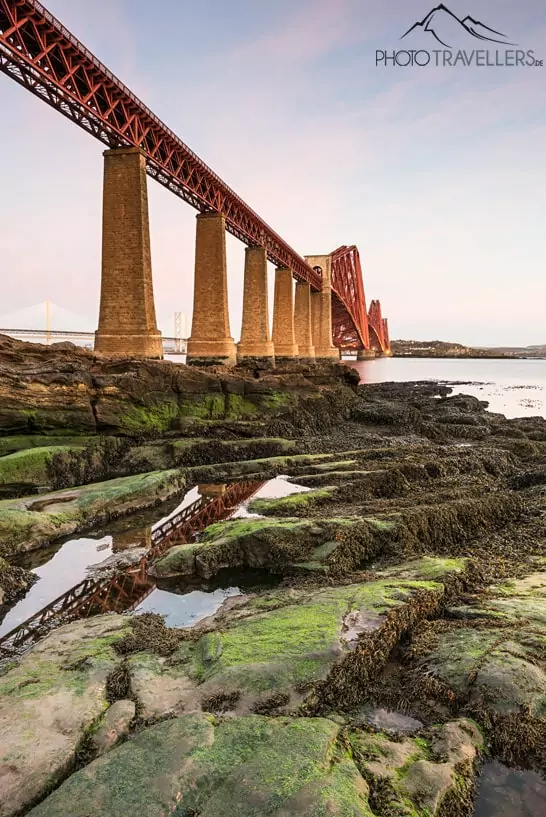
You can order this picture here
About 100 years later, the next bridge, the Forth Road Bridge, was built and opened in 1964. It, too, is over 2.5 kilometers long, but served as a road bridge rather than a railroad bridge like the Forth Bridge. However, there were structural defects that caused the suspension bridge to literally crumble into the sea beneath the vehicles. As a result, to this day it is only open to pedestrians, cyclists, cabs and buses.

The crumbling bridge was relieved in 2017 by the Queensferry Crossing. At 2.7 kilometers, this is the longest of the three Forth crossings and, thanks to the windbreak fences, can be navigated even at high wind speeds – which are not all that rare here.
15. Edinburgh’s Museums
Last but not least, I have one more “sight” for you, which you can customize according to your wishes and preferences – it’s about the many museums Edinburgh has to offer.
Most of them are not too far from the historic center, so you can easily reach them on foot. One of the most central museums, for example, is Camera Obscura and World of Illusions (Website). What is to see in there? As the name suggests, you will see all kinds of illusions and optical illusions here. But a highlight is definitely the 360° panoramic view from the roof terrace of the museum.
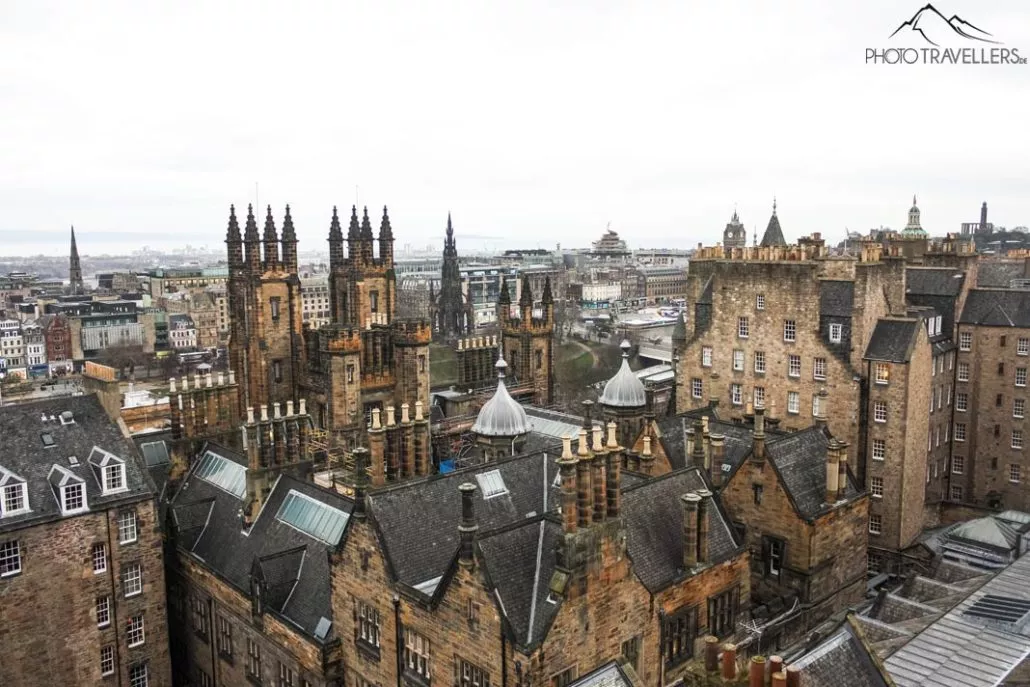
Nearby is a picturesque courtyard called Lady Stair’s Close. Here you’ll find the Scottish Writers‘ Museum (Website), where you can immerse yourself in the lives of three famous Scottish writers: Robert Burns, Walter Scott and Robert Louis Stevenson.
You can also explore whole new worlds at the National Museum of Scotland (Website). Opened in 1998, the museum of Scottish history and culture is really huge and totally impressive in terms of space alone. Admission to the permanent exhibition is free.

Not far away there are two museums you have to see if you are interested in medicine and science. First, the Surgeon’s Hall Museum (Website) at the Royal College of Surgeons, which depicts the history of medicine in Scotland and the Western world and displays many different body parts.
And then there’s the Anatomical Museum at the University of Edinburgh, which is dedicated to anatomy and has about 12,000 exhibits.
If you prefer to look at paintings, the Scottish National Gallery, is the place to go. Or in the Scottish National Portrait Gallery, where there is one thing above all: right, portraits. But also the historic building in which the museum is located is absolutely worth seeing. By the way, both National Galleries are free, but you should register beforehand anyway.
There are many more museums in Edinburgh, but one must be mentioned in any case. The Museum of Edinburgh is also free and takes you into the exciting history of the city. It’s located right at the bottom of the Royal Mile.
Bonus: Edinburgh Festival Fringe
Many travel especially for this, but even if you just happen to be in Edinburgh in August, you can’t miss the Edinburgh Festival Fringe. It will be difficult anyway, because after all the event is the biggest cultural festival in the whole world.
Every year, more than a million tickets are sold for “The Fringe,” as it is known for short. Not only established theaters participate, but also clubs, community spaces or even private living rooms are transformed into temporary venues.
The performances are mainly theater and comedy. Classics such as Shakespeare and Co. are also represented, as are smaller experimental productions.
The whole thing lasts three weeks and attracts not only international artists and performers, but also curious visitors from all over the world. There’s sure to be a show or two that appeals to you – just take a look at the program for the next Edinburgh Fringe!
Unser Hoteltipp in Edinburgh: Black Ivy
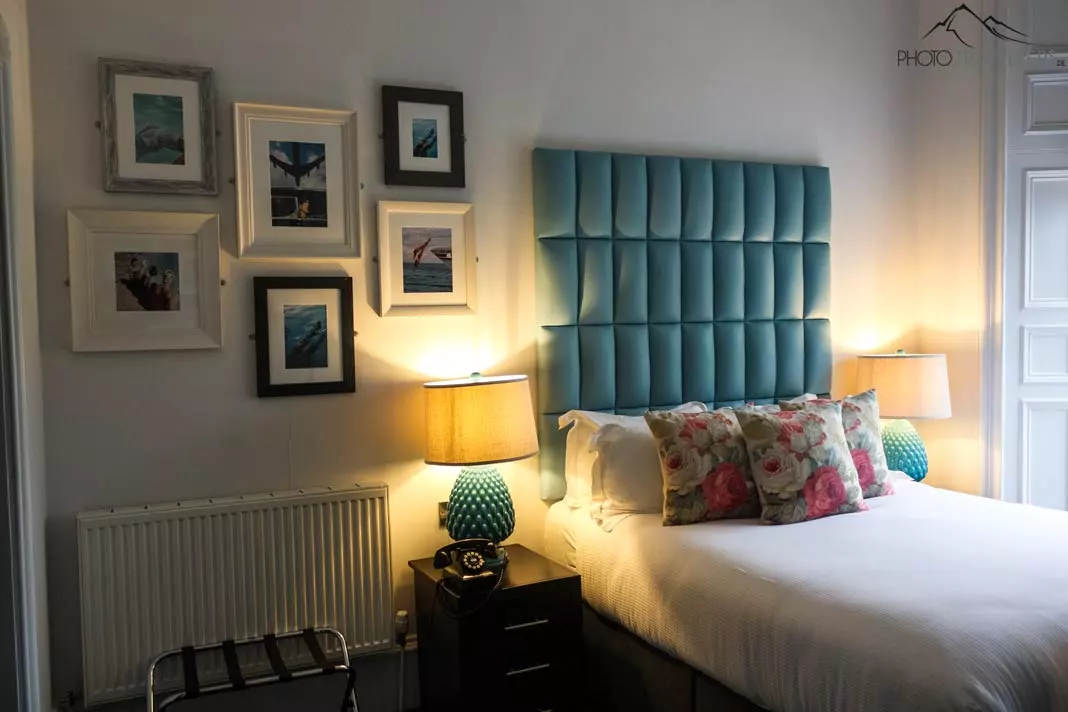 The rooms at the Black Ivy Hotel in Edinburgh are very tastefully decorated
The rooms at the Black Ivy Hotel in Edinburgh are very tastefully decorated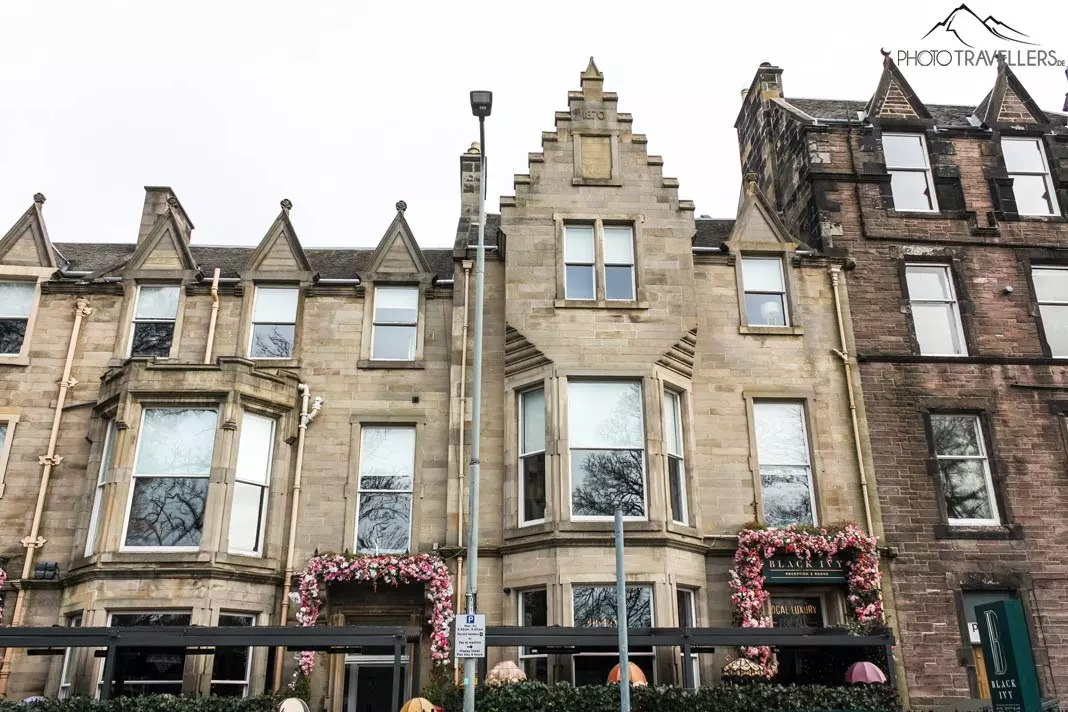 The Black Ivy Hotel is already very nice to look at from the outside – the great facade looks inviting
The Black Ivy Hotel is already very nice to look at from the outside – the great facade looks invitingI also have a real insider tip when it comes to accommodation. The small boutique hotel Black Ivy (Website) is located in Bruntsfield, a quiet, very green neighborhood of Edinburgh. You can reach the historic center, which is northeast of here, in about 15 to 20 minutes on foot.
The Black Ivy is dedicated to the concept of “local luxury,” and it delivers. There are 21 rooms in all, each individually designed to tell its own story.
The high ceilings with stucco and the old wooden sliding windows are typical for this type of building and give the Black Ivy an absolute retro feeling. The deco is also super well thought out and not only color coordinated perfectly with the concept.
So the Black Ivy is the perfect mix: familiar, introspective and cozy, but also elegant, stylish and luxurious.
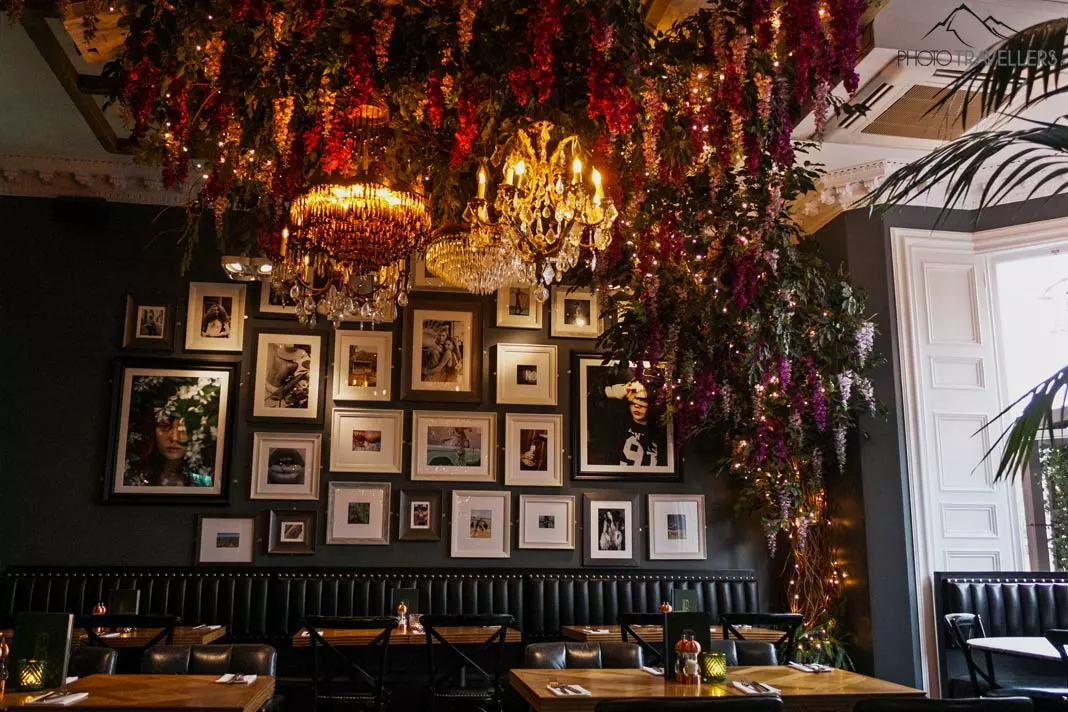 The restaurant at the Black Ivy is beautifully decorated. Here you will spend a great evening
The restaurant at the Black Ivy is beautifully decorated. Here you will spend a great evening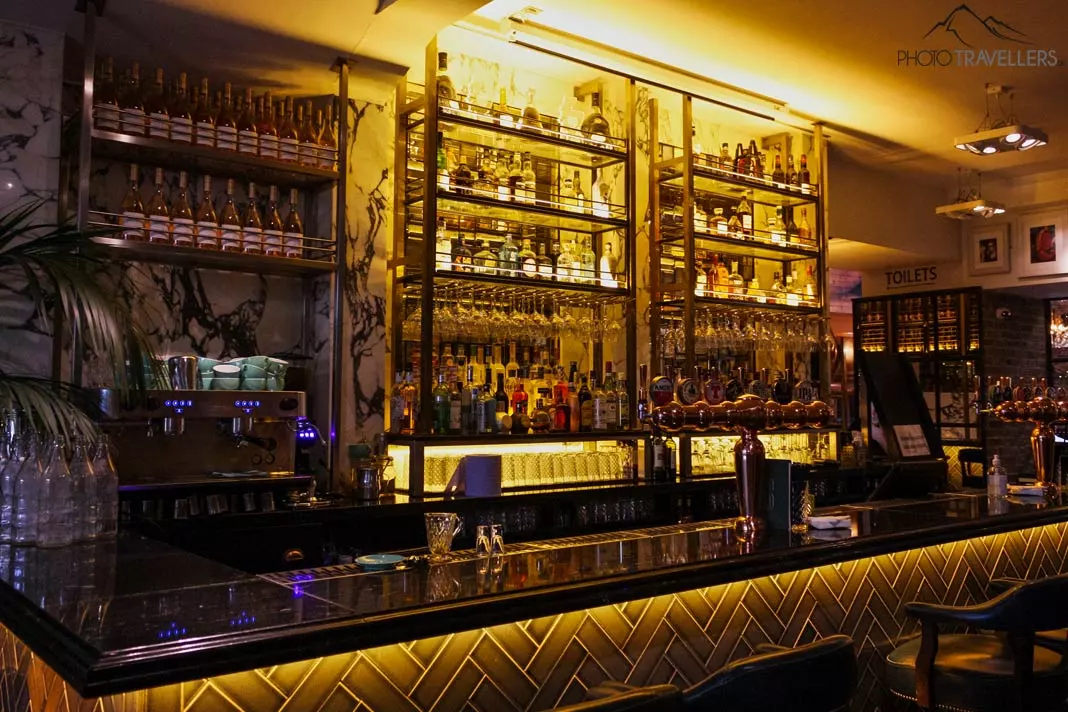 The bar of the Black Ivy Hotel leaves nothing to be desired
The bar of the Black Ivy Hotel leaves nothing to be desiredThis idea is not only reflected in the rooms, but also in the restaurant with bar and terrace, which belongs to the hotel and where, among other things, the varied breakfast is served à la carte. But you can also have a great lunch or dinner here or sit together and sip delicious cocktails until late at night.
The beautiful decor with fairy lights, magical blue rain and warm fireplaces complete the experience and let you immerse yourself in a world of luxury, where you still feel at home.
15 insider tips in Edinburgh
Speaking of insider tips – in Edinburgh there is of course much more to see beyond the classic sights and tourist crowds. Here’s a little inspiration:
- Outlander day trip
- Craigmillar Castle
- Ghost tour through the underground of Edinburgh
- Mary King’s Close
- Burns Night in Edinburgh
- Scotch Whisky Experience
- Edinburgh Gin Distillery
- Panda & Sons
- St Cuthbert’s Kirkyard
- Topping & Company Booksellers
- St Margaret’s Loch
- Dean Village
- Circus Lane in Stockbridge
- School of Divinity
- Armchair Books
5 important Harry-Potter-Spots
And that’s also the keyword for the Harry Potter spots in the city of Edinburgh. Because Edinburgh was definitely in many ways the inspiration for the story of Harry Potter and the many books of the book author J.K. Rowling. I’ll now show you 5 cool spots that you should definitely not miss as a Harry Potter fan.
- The Elephant House
- Greyfriars Kirkyard
- Victoria Street
- The Dog House
- Balmoral Hotel
The Elephant House is a must-see. This is where it all began with Harry Potter, as this is where J.K. Rowling sat and wrote the plot of her idea on napkins. Inside, you’ll see pictures hanging on the wall showing J.K. Rowling working on the book. Be sure to take a look in the restrooms. The signatures of countless Potter fans adorn the walls. Address: 21 George IV Bridge (Google Maps), Opening hours: Monday through Thursday 8 a.m. to 10 p.m. Friday and Saturday until 11 p.m. On Sundays, the café only opens at 9 a.m.
Now we head not far from The Elephant Café to the nearby Greyfriars Kirkyard. There in the cemetery you’ll find tombstones that remind you of some names in Harry Potter. They obviously served as inspiration. For example, William McGonagall, a British poet, is buried there. From him Rowling created Professor McGonagall. In addition, the grave of Lord Voldemord aka Tom Riddle is also buried there (Google Maps). The real name of the eponym is Thomas Riddell. To find the graves, go to the left back part of the cemetery. Address: 62 Candlemaker Row
Another landmark that is said to have influenced the book is Victoria Street. Either way, Potter fan or not, this is a place you must see. Colorful little houses line up here. They’re all eye-catchers. The street is said to have served as inspiration for Diagon Alley. Now, of course, some Harry Potter stores are located here, selling souvenirs. Address: Victoria St (Google Maps)
Tip: At 40 Victoria St, you’ll find a store that’s designated as a Harry Potter museum. A top thing to do in Edinburgh!
If you’ve always wanted to try the butterbeer from Harry Potter, The Dog House (Google Maps) is the place to go. You’ll pay £4 for a pint of butterbeer here. Our tip: Buy one first and share it with others. Because Butterbeer really has a stiff taste that only hardcore fans like. Address: 18-24 Clerk St (Google Maps). The pub is open Monday through Saturday from 12 to 1. On Sundays, it opens at 12:30.
And to finish off the top 5 Harry Potter spots, I suggest the Balmoral Hotel (check rates here*) on Princes Street. It was here, in room 552, in what is now titled The J.K. Rowling Suite, that the author wrote her last books. After all, at some point she was too well known to write in her favorite cafés, The Elephant House or the Spoon Café. A night in the suite costs a hefty 2000 pounds for two adults, including breakfast. For that you have pure luxury in the 5-star Rocco Forte hotel with Italian marble bathroom with tub and walk-in shower. We advise you to just take a look in the lobby. The hotel is a real attraction even without an overnight stay.
Tip: if you travel further in Scotland, the Harry Potter bridge, the Glenfinnan Viaduct is certainly very exciting for you.
By streetcar to Edinburgh
We were in Scotland with a camper-mobile on the road. That was honestly too bulky for us in the city. Therefore, we drove with the camper to the commuter parking Ingliston Park & Ride (Google Maps) not far from the airport. We parked in the free lot and took the streetcar into Edinburgh. So early in the weekend there is enough space in the parking lot. At other times and on weekdays, however, it can sometimes get very crowded.
By the way, you have to buy the ticket for the streetcar at a machine on the platform. If you get on the streetcar without a ticket, you pay ten pounds. Guaranteed, because every streetcar is controlled by a conductor.

History of Edinburgh
By the way, the history of Edinburgh goes back to prehistoric times. In the early Middle Ages, when the region was called “Eydin”, the present name of the city was formed: “Din Eydin”, meaning “Castle of Eydin”.
Later, Edinburgh received the nickname “Auld Reekie”, which means “Old Smoky” and goes back to the many factories with their chimneys. Much nicer are the nicknames “Athens of the North” or “My own romantic town”, as the city was called by Theodor Fontane and Sir Walter Scott.
Curious facts about Edinburgh
- Edinburgh was the first city in the world with its own fire department
- Edinburgh is the greenest city in the United Kingdom, as it has the most trees per inhabitant.
- Edinburgh Castle was once home to an elephant – it was brought from Sri Lanka and he loved to drink beer
- Edinburgh is the city with the most listed buildings in the world
- There is a clock in Edinburgh that is always two minutes fast – it is located on the clock tower of the five-star Balmoral Hotel on Princes Street, which is right next to the main train station. The reason: this was to ensure that passengers would not miss their train. Only on New Year’s Eve does the clock go right
Für unsere Leserinnen und Leser aus Deutschland: Hier findest du die Top-Sehenswürdigkeiten in Edinburgh auf Deutsch.
